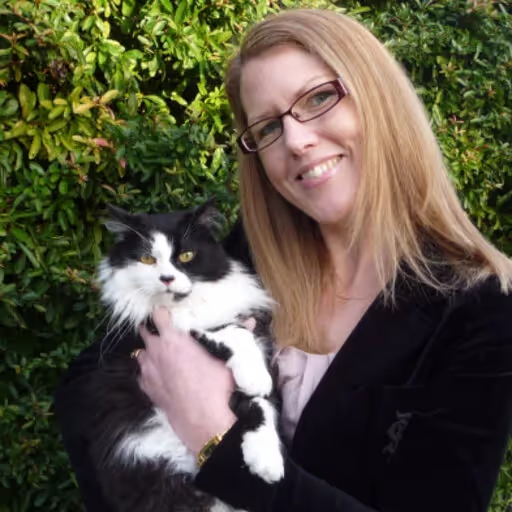Resources
Stay up-to-date with VetLed news and events, browse our blogs, download free resources, and follow our campaigns.

Many of us spend so much time at work that our colleagues feel more like family or close friends, especially when we take on the stresses and pressures of veterinary life together. This feeling of being 'in it together' can strengthen team bonds and provide comfort and support, but it can also make it easy to miss the signs that someone in the team is struggling.
My experience…
I’ve experienced my fair share of mental health challenges during my veterinary career – I embody the perfectionist streak that’s so common in our profession. When I graduated, I was suddenly blindsided by the feeling that I wasn’t good enough or didn’t know enough, so of course, I threw all of my energy into trying to make sure nobody found out! At a time when I was already under a lot of pressure to learn on the job, put my knowledge into practice, and learn new skills, it was tough keeping up the façade that I was coping… succeeding… and even enjoying it. After all, this was all I’d ever wanted to do and I knew I should be grateful.
It lasted all of three months. I broke down at a work social event and admitted some of my fears to a colleague. Since then I've received support in different forms, from colleagues, bosses, friends and family, and therapists. I've often felt much better, but I've also relapsed and had moments when those imposter thoughts would win and I'd feel like I was a new grad again, not someone with over ten years of clinical experience. It's a work in progress, but I could never have started if I hadn't opened up.
How to spot subtle signs that your colleague might need support
During those first three months, it wasn't obvious that I was struggling. I turned up and did my job well, I asked a few questions but was often self-sufficient, I shared jokes with colleagues, chatted about my weekend, and probably appeared to be doing just fine. No one could tell I was lying awake at night going over the cases I'd seen and whether there was anything I could have missed. No one saw me subtly checking all of the cases I'd seen when I was on call to make sure none had died and I did my best to hide the 'doom feeling' if I found one that had, while I frantically searched for clues about whether I was at fault or it was unrelated.
In such a high-performing career, it's natural that many fight to avoid showing signs of weakness. However, that does mean it's more challenging for the rest of the team to support them. So, what signs might suggest that a colleague is having a tough time personally or professionally?
- They’re not around for breaks
When things feel tough, it sometimes feels like all you can do is keep going. If you have a colleague who regularly works through their breaks, it could be a sign that they’re feeling overwhelmed. On the other hand, if a colleague usually spends their breaks with the rest of the team but they start choosing to be alone, this could be a sign that they’re struggling.
- Their timings change
When dealing with mental or physical health challenges, it’s hard work just getting out of the door in the morning. These issues can also go hand in hand with poor sleep, making mornings even harder. A colleague who is suddenly regularly late for work, or unusually early for work if they have been unable to rest and can’t switch off, may need some support.
- They’re picky about the work they do
This one I can personally relate to – when you’re a vet or vet nurse and feeling anxious, stressed, burned out, etc. you might start to protect yourself (consciously or unconsciously) by avoiding consults or surgeries that seem more challenging. It’s important to understand this because it’s easy, as a colleague, to become frustrated. After all, if a vet who you believe is more than capable appears not to be doing their fair share of the work, or leaving the harder bits for someone else, your initial assumption might be that they’re lazy, can’t be bothered, or don’t care about their colleagues. But what if there was another reason? What if they are just in survival mode?
How can you help a colleague who’s struggling?
Every relationship between two colleagues is different, and how you approach offering help and support will depend on your unique relationship. However, these tips could be useful in getting started:
- Ask ‘Is everything okay?’
Perhaps a good place to start is being gently curious when there's no one else around, without creating any pressure for them to share. You might find that they’re relieved to have been asked or that starting the conversation leads to more natural opportunities for them to share going forward. If 'Is everything okay?' seems too broad or pointed, consider a more specific conversational question like 'How was your day?' to get the conversation going.
- Let them know you’re concerned, without judgement
If they say everything’s fine or avoid the question, it might be appropriate to say you're concerned about them. Avoid listing specific observations as evidence if they could be interpreted as criticism, for example, ‘I noticed you were late today’ – letting your colleague know that they’re not managing to keep up appearances is likely to make them feel much worse. This could lead them to be more self-critical and worry more about what management thinks or their job security. Instead, identify yourself quickly as someone who cares and wants to help, then give them time to process.
- Share your own challenges
Sharing is hard, especially if it seems like everyone else is finding the job easy or taking it in their stride. Starting a two-way dialogue where you show your vulnerability and fallibility by sharing a recent case or situation that you found difficult could help you seem more approachable to your colleague.
- Work on whole-team wellbeing
As to whether you should or shouldn’t share your concerns for your colleague with your boss… for me, there's no clear-cut answer. Of course, if you are concerned for their safety or that of their patients, letting someone trusted in management know is probably unavoidable. However, letting management know if your colleague has confided in you could damage your relationship and prevent you from helping them further. Whether you share your specific concerns with your boss or not, suggesting that the practice clearly signposts support services like Vetlife and promotes team wellbeing by encouraging team members to listen to their needs, take time out when they need it, and share their struggles, will remove any stigma around needing help and benefit the colleague indirectly. You may do this by introducing wellbeing rounds, Schwartz rounds (after suitable training) or through wellbeing training, like ourHALT workshopsand HALT campaign.
Summary
It’s not always easy to spot the signs that a colleague is having a hard time, and even if you have a suspicion, trying to find the right words to get them to open up or accept support without causing offense or making them feel worse is another challenge. Look out for changes in their usual routine and behaviours, and let them know gently and compassionately that you’re concerned about them, without making them feel cornered or judged. Signpost sources of support, and if you have serious concerns for your colleague’s safety, speak to someone you trust in the management team.

Being a vet or vet nurse can feel draining. Yes, they're really rewarding roles and we get to make decisions, start treatments, and perform procedures that have a clear positive effect on the lives of animals. But the hours can be long and the pressure and responsibility high, and it’s particularly tough when the outcome for the patient doesn’t reflect our hard work. But it’s worth it, right? Because working in veterinary is something we always dreamed of.
But what if you have another dream? What if you’ve always seen yourself settling down and having children and a family life? Is that compatible with a fulfilling career in veterinary? Can you really have both?
Being a parent brings a mixed bag of rewards and challenges. Different life stages present various struggles, from the exhaustion from disturbed sleep from night feeds and co-sleeping in the early years, to the mental strain of organising childcare and travel to clubs and hobbies as children grow. All the while, you’re shaping a little person – doing your best to give them the best foundations for a good, happy life with healthy relationships.
Do you really have enough in the tank to pursue both dreams? Maybe, but it’s not easy.
It's unsurprising, then, that many vets and nurses who are also parents have poor wellbeing. After all, it’s easy to overlook our own wellbeing in any scenario, let alone when there are poorly patients or dependant little people demanding our time. So, how do we prioritise our wellbeing when juggling parenthood and a busy work life?
- Plan ahead
When life is overwhelming and you're busy, it can feel like you're just muddling through the days as best you can with no real plan. But planning for the week can give you a sense of control, helping you to identify any time-keeping issues in advance and keep things running as smoothly as possible. Of course, it takes a little more time at the start of the week, and things are subject to change. But if you have a vague idea of what you and your family are doing each day, you might feel a bit lighter because there are fewer worries causing background noise in your brain.
- Share the load
If you have a partner, family, or close friends to lean on, try to delegate some of the responsibilities. Having a shared calendar with your partner (or anyone else who's a big part of your family life) will keep them informed and involved in any problem-solving of clashing commitments.
- Be realistic
You’re just one person, and as much as you might strive to be SuperMum or SuperDad, taking on too much will only add pressure that you don't need. It's easy to feel like you should be giving more – staying longer at work to help a colleague or using your only half day to take your child on an amazing outing – but is that sustainable? Remember the importance of rest and that you can be more present for your children and patients when you're not feeling stressed, overwhelmed, and exhausted.
- Be prepared
Make taking a break as easy as possible by being prepared. I bet you’re used to packing a bag full of snacks and drinks for your child when you go out, but do you ever bring anything for yourself? Packing a few feel-good, energy-boosting snacks when you go out for work or recreation will mean you have no excuse not to take a few minutes for yourself – the food is there ready for you.
- Share your needs
If you’re regularly missing your breaks at work, working overtime, or missing your child’s bedtime, it’s time to speak to your employer. Think about what would make this period in your life easier for you, whether that’s a change in work pattern, reduced hours, or a commitment to regular breaks. Perhaps you’re a breastfeeding mum who needs regular time to pump. Whatever you need, start the conversation with your boss.
Of course, it’s also important to share your needs outside of work with your partner or family. If the parenting load feels unbalanced, or there’s just something you’d like more help with, speak to your support network and let them know how they can help.
- Seek support
It might feel like it, but you're not alone in your struggles. Parenthood is often depicted as a highlight reel, full of rewarding and treasured moments and without any of the tantrums, arguments, and challenges. If you're finding it hard, you're not failing. You're not ungrateful. There's nothing wrong with you, nor your child/children. You're doing your best and you're doing a great job. Don't be ashamed to be open with your partner, family, and friends, or reach out to your employer or GP. Often, some of the best support comes from other parents who can really relate, so why not speak to friends who are parents or look for groups for parents in your area?
- Allocate time for you
Time for yourself might feel like it’s way down your list of priorities, but should it be? Remember, we can’t care for others, whether our patients or our families, on an empty tank. What makes you feel replenished? It's different for everyone and changes depending on the situation. Perhaps right now you need rest, or maybe you need quiet time to read away from the sensory overload of barking dogs or screaming children. Or are you craving the opportunity to do something you enjoy, a hobby or activity that's been neglected due to lack of time? It's not selfish to take time for yourself. Creating a regular slot where you do something for yourself will promote your sense of self and give you something to look forward to.
- Be kind to yourself
Above all, be kind to yourself. Life is messy and, even with the best intentions, there'll be times when your wellbeing drops off your radar. Don't use this as an opportunity to make yourself feel bad. The most important thing is to keep trying to create good habits that promote your wellbeing, so focus on the steps you've taken and how far you've come, not on the occasions when a busy life got the better of you.
Need more help?
VetLed’s HALT campaign is creating waves in the veterinary profession as it aims to make meeting our needs the norm in every practice and organisation. Resources like practice posters and information sheets act as great reminders and conversation starters. We can also provide HALT training workshops for your team, where we share the impact of poor wellbeing on patient safety (and our own health) and explore strategies to make wellbeing a priority within your team.
Flexee Vet is constantly working to promote flexible working for vets and nurses. Check out their social media for tips and support for making flexible working a reality.

Introduction
In this second blog, we will build on veterinary identities learning to offer practical steps to raise awareness of and challenge unhelpful professional discourses and improve workplace culture and the everyday lives of vets in practice. We will also discuss how we can support vets struggling with flawed versions of who they are.
Professional discourses
Images of the ideal vet can be hugely beneficial for aspirational vets to aim for in their identity work. Ideals spur vets on to learn and grow as clinicians and to do their best for their patients and clients. The construction of preferred identities is also associated with feelings of happiness, self-assurance and pride. However, strong collective understandings of what makes a perfect professional can have a detrimental effect as vets encounter real-world cases that do not respond as expected, critical colleagues, and challenging clients. Vets talk of how the extremes of vetting can lead to widely varying emotions ranging from euphoria and gratification to devastation, guilt, and shame. Recognising professional anxieties and challenging attachment to veterinary ideals may help the profession and organisations better support vets to manage the highs and lows of their everyday lived experiences and so better manage their mental health.
The profession is changing and now talks more openly about veterinary error and promotes no-blame learning environments, but there is a persistence to inherent discourses of perfection and those that say ‘good’ vets do not make mistakes. We can assist by calling out these implicit assumptions and encouraging professionals to ask for and offer help following veterinary mistakes. We can also actively engage with, rather than distance ourselves from, those constructed as flawed vets, so people don’t feel isolated after making mistakes.
Easing the transition from university to practice
We may be able to assist with the transition from university to practice by introducing uncertainty into scientific teaching to help vets better cope with inevitable real-world incidences where presentations do not match textbook descriptions and animals do not respond or recover as expected. The anxiety created by assumptions of perfection, belief in idealised veterinary images, and the consequent dread of the imposition of ‘bad vet’ identities can lead to recent graduates struggling with decision-making for fear of doing something ‘wrong’. Increased comfort with uncertainty and unpredictability may assist individuals to step back from unexpected outcomes, ask for help, assess the case with colleagues, learn and move forward.
More experienced vets can also play a part by recognising and challenging their own and others’ behaviours emanating from the formation of preferred identities. Identities are inherently fragile, so comparing oneself to others who may be viewed as less experienced, knowledgeable or competent and incorporating those assessments into identity stories is universal. It is the language and behaviours experienced by others as denigrating that can cause harm, not just to those who are the object of the comparison, but also those who witness it, and this can be reflected on and adjusted. By extension, if you have experienced a colleague’s demeaning behaviour at work, it may help to know that this conduct likely stems from the comparator’s insecurity rather than the subject’s professional (in)adequacy. Knowledge of this type of comparative identity work may assist with viewing challenging behaviours in a different light and open up a wider range of opportunities for working with individuals to effect change.
Adjusting behaviours to be more collegiate and supportive has the added benefit of improving psychological safety and encouraging less experienced others to more readily ask for advice and guidance because they are less likely to be concerned about appearing ‘stupid’ or to form a flawed identity (and experience the associated anxiety and distress). The likelihood of adverse events may also be reduced as veterinary colleagues work together to solve problems, ensure the health and welfare of animals, and take better care of themselves and each other.
Managing veterinary errors
Dominant discourses within the veterinary profession may underpin the dichotomy of externalizing or internalizing blame for veterinary mistakes. Recognizing the conflict between the historic discourse of individual responsibility and the need to apportion blame versus the contemporary professional commitment to no-blame learning environments may assist vets to respond to mistakes more productively and to feel less isolated. Dismissing mistakes as emanating from external factors beyond the vet’s control or constructing them as a demonstration of innate personal failing may lessen the opportunity to learn. Whereas if we step back, complete a human factors assessment and recognise contributing elements, we can approach learning collectively and take steps to make practical changes to systems, processes, and environments to reduce the likelihood of future mistakes. We can also support each other to repair preferred identities rather than maintain flawed versions of ourselves.
Concluding thoughts
Hopefully, this second blog has provided food for thought on challenging unhelpful professional discourses, the impact identity work can have on colleagues, learning from veterinary errors, and how we can better support one another to repair preferred identities and manage flawed ones. Not only will changes in professional and workplace culture assist vets to manage everyday work experiences more effectively and improve their mental wellbeing, but it will also benefit the animals they treat, the clients they serve, and the businesses they work for.
If you’d like to discover more about how you can adapt the way you work as a team to make mistakes less likely, look out for tickets for the next Veterinary Patient Safety Summit, happening in 2026!
You can also join our monthly Patient Safety CPD meetings - the Veterinary Patient Safety Forum. This free event is online on the first Thursday of every month. Find out more here.

Introduction
In this mini-series, we’ll first explore the link between veterinary error and identities. By learning how error narratives are incorporated into identities, we can better understand how we become the people we are and why we feel the way we do about errors. In the second blog, we will discuss what we can do from a practical perspective to support ourselves and others in recovering from difficult experiences. The findings described herein are taken from an empirical study into veterinary identities.
Veterinary identities
Vets, like other professionals (e.g., academics, doctors, priests, airline pilots), often speak of the centrality of work to their identities, incorporating what they do into who they are, making it hard to separate oneself from one’s work. Identities can be thought of as subjectively constructed through the stories told both in monologue and to others with oneself as the central character. In this context, identities are the meanings individuals attribute to themselves when answering questions such as ‘who am I?’. Identities are never fixed or complete; they are continuously worked on (to a greater or lesser extent) – a process known as ‘identity work’ – as individuals form, strengthen, maintain, repair, and revise who they are through telling and re-telling self-narratives over time.
Identity narratives are not formed spontaneously but are drawn from occupational discourses – the images, descriptions, assumptions, and stereotypes that make up our collective understanding of what makes (for example) a ‘good’ or ‘bad’ vet. To illustrate this point, picture for a moment what you understand to be a ‘good’ vet. Your understanding may correlate with other vets who, when constructing preferred identities, often talk about themselves as competent, hardworking animal lifesavers and fixers who are respected by colleagues and much-loved by clients. In comparison, if you imagine a ‘bad vet’, you might identify with vets who talk of their flawed identities as lazy, incompetent animal harmers and killers who are denounced by colleagues and unappreciated by clients.
The prominence of idealised veterinary images means that vets often believe perfect identities are achievable/achieved by others. Consequently, it can be difficult to navigate experiences that suggest imperfection. Younger vets in particular can struggle with the tension between aspirational ideals of perfection and the impossibility of ‘being’ perfect. As a result, they may experience considerable anxiety and insecurity. Individuals may worry that they are not (and may never be) good enough professionally (or even personally).
Veterinary error
The assumption that making a mistake is synonymous with failure, litigation, and being ‘struck off’ is common to vets and doctors. Despite advances in how veterinary errors are depicted, vets can draw on historic discourses, for example, that good vets don’t make mistakes or that veterinary errors result from personal failings. Veterinary errors can take many forms, including mistaken or missed diagnoses, patient morbidity or mortality, or medication errors. When they occur, vets can experience a multitude of feelings, including fear, self-doubt, inadequacy, vulnerability, distress, guilt, sadness, shame and isolation as colleagues distance themselves from error making others.
Some vets say they externalise blame by utilising defensive identity work strategies to distance from error-making identities, including denying mistakes happen or suggesting inferior vets make mistakes in comparison to their perfect selves. Others draw on discourses of human fallibility and suboptimal circumstances, blame clients and colleagues for mistakes, construct mistakes as recognized complications, or reassure themselves that the animal would have died anyway, or that a worse mistake could have been made.
In contrast, other vets say they maintain flawed identities, particularly following veterinary errors that lead to animal death, and above all, unexpected (anaesthetic) deaths. Some vets state they find it difficult (or impossible) to move on from mistakes, perpetually re-living the incident in their minds, whilst others say they will vividly remember mistakes (including the names of associated animals and clients) for the rest of their lives. Whilst those who employ strategies to distance themselves from mistakes appear better able to move on, those who maintain flawed identities talk of experiencing significant distress and mental ill health, including suicidal ideation.
Even when mistakes have not occurred, some vets describe catastrophising about imagined errors and routinely accessing the practice management system or phoning the duty vet from home due to the fear that a patient’s condition may have worsened (even when procedures have gone well). Some speak of waking up following work-related nightmares or convinced they have done (or not done) something terrible or that an animal they treated during the day has died.
Insecure identities
Because identities are continuously worked on, they are inherently insecure. Consequently, when working on preferred identities, some vets talk disparagingly about others (characterised as ‘lesser’ individuals) to construct stories of themselves as ‘good’ or better vets in comparison. Conversely, when working on flawed identities, vets often compare themselves to others they feel are more competent and worry about what colleagues think of them. This is especially noticeable in environments that people experience as competitive or judgemental. Knowledge of how identity work influences interpersonal interactions can help us understand why some people display challenging behaviours at work and recognize the impact of underlying assumptions, beliefs, attitudes and feelings on workplace culture.
Concluding thoughts
Hopefully, this brief review of veterinary identities has struck a chord with readers. In the second blog, we will explore how we can leverage our understanding of identity work to provide practical tips on supporting vets to manage everyday work occurrences and to repair preferred identities following difficult experiences.
If you want to explore veterinary error and patient safety further, join VetLed's free, monthly online CPD meetings - the Veterinary Patient Safety Forum
VetLed will also return with another Veterinary Patient Safety Summit in 2026 - watch this space for more details!

Are you new to a leadership role?
Or do you know you could do a better job with the right tools and support?
Our first Open Leadership Programme begins on 10th December! (with an optional Welcome Session on 12th November)
Just like our existing Leadership Programme, this is an 8-module, 8-month programme focusing on topics like giving and receiving feedback, compassionate communication, decision-making, and impacting workplace culture (for the better!).
However, now you don't need to wait for your boss or other leaders in your team to be eager and engaged, ready for an in-practice course!*
Instead, you can join like-minded leaders from other practices who are focused on developing their leadership skills to help them feel more comfortable and effective in their role.
This programme is delivered completely online, with live sessions and pre-recorded content, as well as paired reflective exercises.
Our monthly sessions will be on Wednesdays at 10am UK local time, and we'd advise not missing more than two of them (not including the welcome session in November). Click the button below to book your place before 31st October.
*That's not to say it wouldn't be great to do it with a colleague for maximum impact on your team! So, if you have a small group who'd like to join together, that's fine too!
BOOK YOUR PLACE NOW

The Veterinary Patient Safety Summit 2025 took place at Consort E3 at Harper and Keele Vet School on 17th October. It was a sold out event, full of passionate patient safety advocates. In November's Veterinary Patient Safety Forum, we'll share insights from the day that you can bring to your team. Join us online at 1pm local UK time for this free monthly event.

What are the aims of the Safe To Speak Up campaign?
To raise awareness of the importance of psychological safety in veterinary practice.
To enable all members of the veterinary team to encourage Psychological safety and embed it into the organisational culture of veterinary practices so that every one feels SAFE TO SPEAK UP.
What is Psychological safety and why is it important that we feel safe to speak up?
Psychological safety is broadly defined as a climate in which people are comfortable expressing and being themselves, more specifically when people have psychological safety at work they feel comfortable sharing concerns and mistakes without the fear of embarrassment or retribution. They are confident that they can speak up and won’t be humiliated, ignored or blamed. They can ask questions if they are unsure of something.
Psychological safety has been identified as key differentiator between higher and lower performing teams in studies of professionals in a variety of industries. ” It was identified by Google at the most important aspect of building a successful team as part of a two-year study – project Aristotle and was found to underpin the other four key dynamics: dependability, structure and clarity, meaning of work and impact of work.
It is known that when workplaces offer a high degree of psychological safety good things happen- mistakes are reported quickly so prompt correct action can be taken, coordination and communication across groups is good and ideas are shared. When there is psychological safety team members feel confident that no one on the team will embarrass or punish anyone else for admitting a mistake, asking a question, or offering a new idea.
What happens when we don’t have psychological safety?
When we experience stress or fear at work, our amygdala is activated (the part of our brain that is responsible for detecting threats) this causes a physiological response and hormones are released which prepare us to have to fight, run or freeze, as our brain focuses on this it shuts down our ability to think strategically and shifts our behaviour from reasonable and rational to primal and reactive. Fear inhibits learning, impairs analytical thinking, creative insight and problem solving.
The most common triggers of our stress response in practice include:
Unrealistic workload
Lack of respect
Unfair treatment (especially following an adverse event or near miss)
Not being heard
Being unappreciated
What are the benefits of psychological safety?
- We know that feeling SAFE TO SPEAK UP creates a positive emotional state which in turn creates a state of trust and curiosity and causes the release happy hormones like dopamine and serotonin which have been found to:
- Improve our cognitive ability. The brain has been found to be 31% more effective in thrive state compared to neutral or survive state.
- Improve our ability to learn and remember new information
- Broaden our minds
- Improve resilience and persistence and enables us to build personal wellbeing resources.
- Enables us to share ideas for innovation, improvement and advancement and talk about error in a safe environment.
All these things contribute to improved team performance and reduced error which ensures that patient safety is maintained.
How to build psychological safety?
To find out more about how you can build psychological safety in your workplace and make sure that every member of the team feels #safetospeak up why not join our upcoming Psychological Safety Masterclass? Email hannah@vetled.co.uk for more information on how to book.
Want to support our campaign AND remind your team of the importance of working towards psychological safety? Download our practice poster using the button at the top of the page!
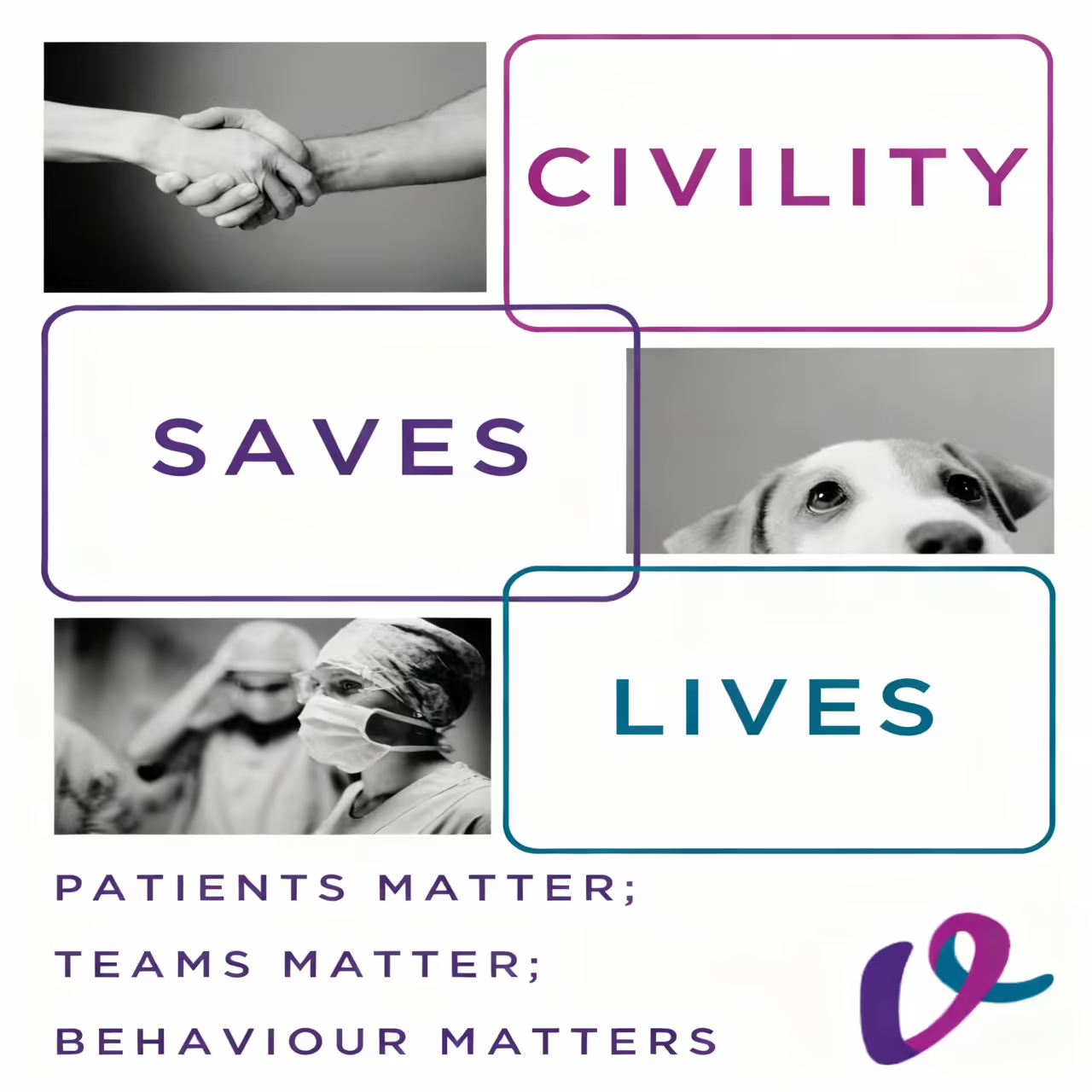
Campaign Summary
The Aim
The aim of the VetLed Civility Saves Lives Campaign is to raise awareness about the importance of civility and focus on the positive steps we can take to reduce the frequency of incivility in veterinary practice.
The VetLed Civility Programme offers practices in-person bespoke training to support your whole veterinary team.
The Facts
The “Behaviour in Veterinary Practice” Survey (2017) by vetsurgeon.org and vetnurse.co.uk found:
- 73% of respondents have been belittled in front of other staff
- 65% of respondents have been criticised minutely
- 54% of practice managers have been shouted or screamed at
- 48% of nurses have felt deliberately excluded or ignored
Incivility is defined as rude or unsociable speech or behaviour.
The most important thing to remember is that rudeness is defined by how the recipient interprets it, regardless of the intent.
Rudeness can take many forms — it can be insidious or blatant and may include:
- Verbal aggression
- Blaming
- Inappropriate humour
- Closed body language
- Public humiliation
In another survey of doctors and nurses, 75% identified bad behaviours within their teams that led to medical errors, and 25% believed these behaviours contributed to patient deaths.
Why We Are So Passionate About Civility
We often feel that rudeness and incivility are “just part of the job” in stressful workplaces.
However, developing civility is critical to performance and patient care.
Porath and Pearson (2013) found that:
- 80% of recipients of incivility lose time worrying about it afterwards
- 38% deliberately reduce the quality of their work
- 78% reduce their commitment to work
Civility really does save lives.
In leadership, we must consider the wider impact of incivility — clients may be 75% less enthusiastic about an organisation after witnessing incivility.
It Matters for Teams
Rayner:
25% of bullied victims and 20% of witnesses leave their jobs.
It Matters for Clients
With the veterinary profession facing significant recruitment issues, it is vital that we take active steps to reduce incivility.
It Matters for Practices
Healthy workplace culture improves retention, morale, and client satisfaction.
The Solution: A Balanced Approach
Individual
- Make an effort to adopt and exhibit civil behaviour as a non-negotiable part of our character.
- Ask yourself: “Could what I am saying be interpreted as rude?”
- If yes, apologise — even if only to avoid being misunderstood.
- Be aware of the impact of your thoughts, actions, and words.
- Acknowledge your responsibility to ease others’ experiences.
- Call out incivility with compassion.
Team
- Excel in teamwork to reduce external stressors that may lead to incivility.
- Nominate a civility champion.
- Get your team bought in — explain why civility matters to them.
- Discuss the topic at practice meetings or during lunch-and-learn sessions.
Organisation
- Avoid employing individuals who have exhibited uncivil behaviours in the past.
- Consider adopting a zero-tolerance policy.
- Ensure disclosed core values are upheld.
- Book a VetLed Civility Programme workshop.
- Download and display free posters to reinforce positive culture.
What Can I Do?
We believe the VetLed Civility Saves Lives Campaign will have a positive impact on your team.
It aims to help establish a culture in which all members feel safe at work — where everyone supports each other to perform at their best and provide the highest level of patient care.
Positive team dynamics and healthy relationships are essential for high-performing veterinary teams. Tackling incivility is critical to achieving this.
Every practice is different — please consider how to apply this campaign safely and effectively in your workplace.
Download our Civility Saves Lives practice poster by clicking the button at the top of the page!
For more information or support, contact info@vetled.co.uk.
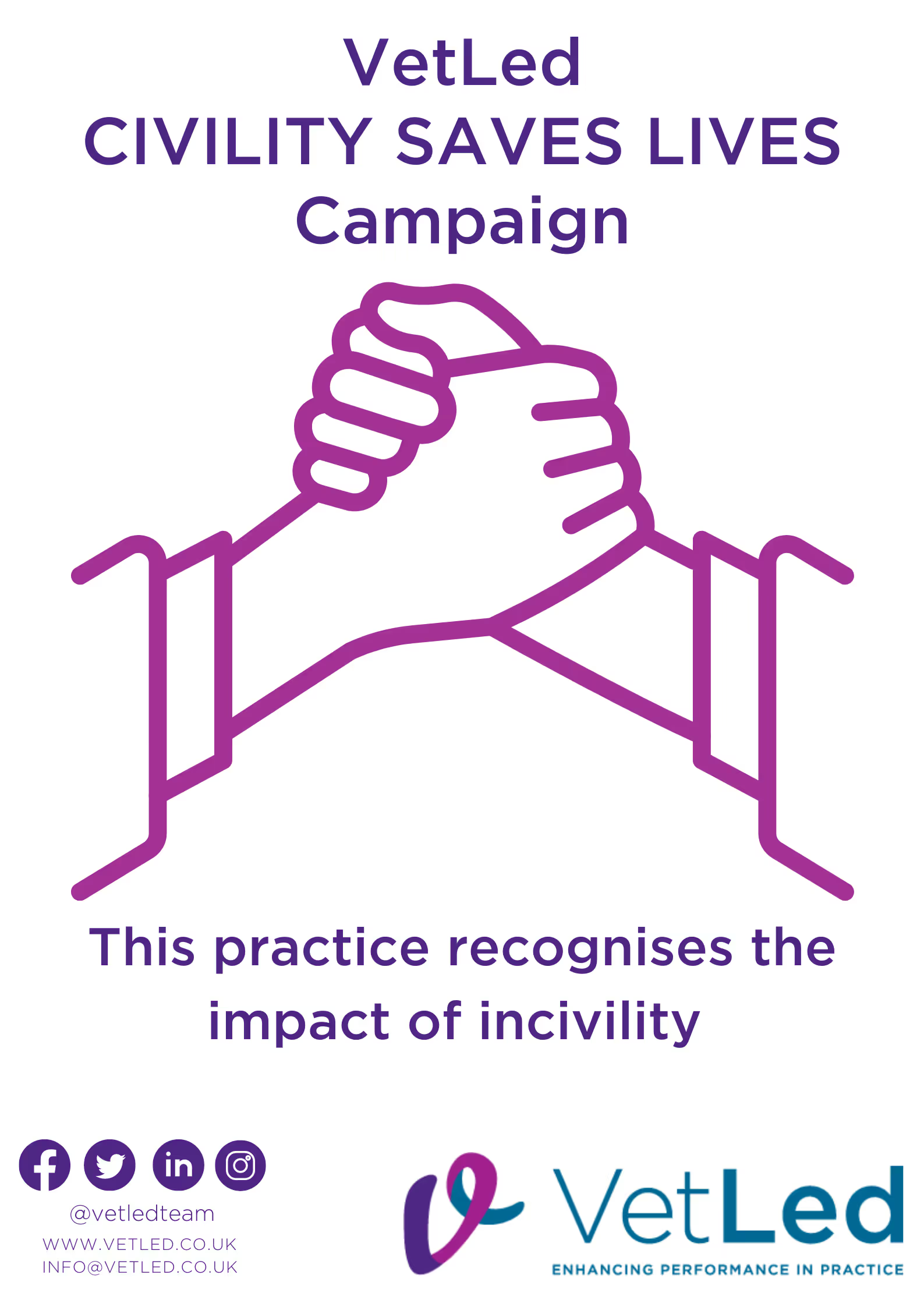
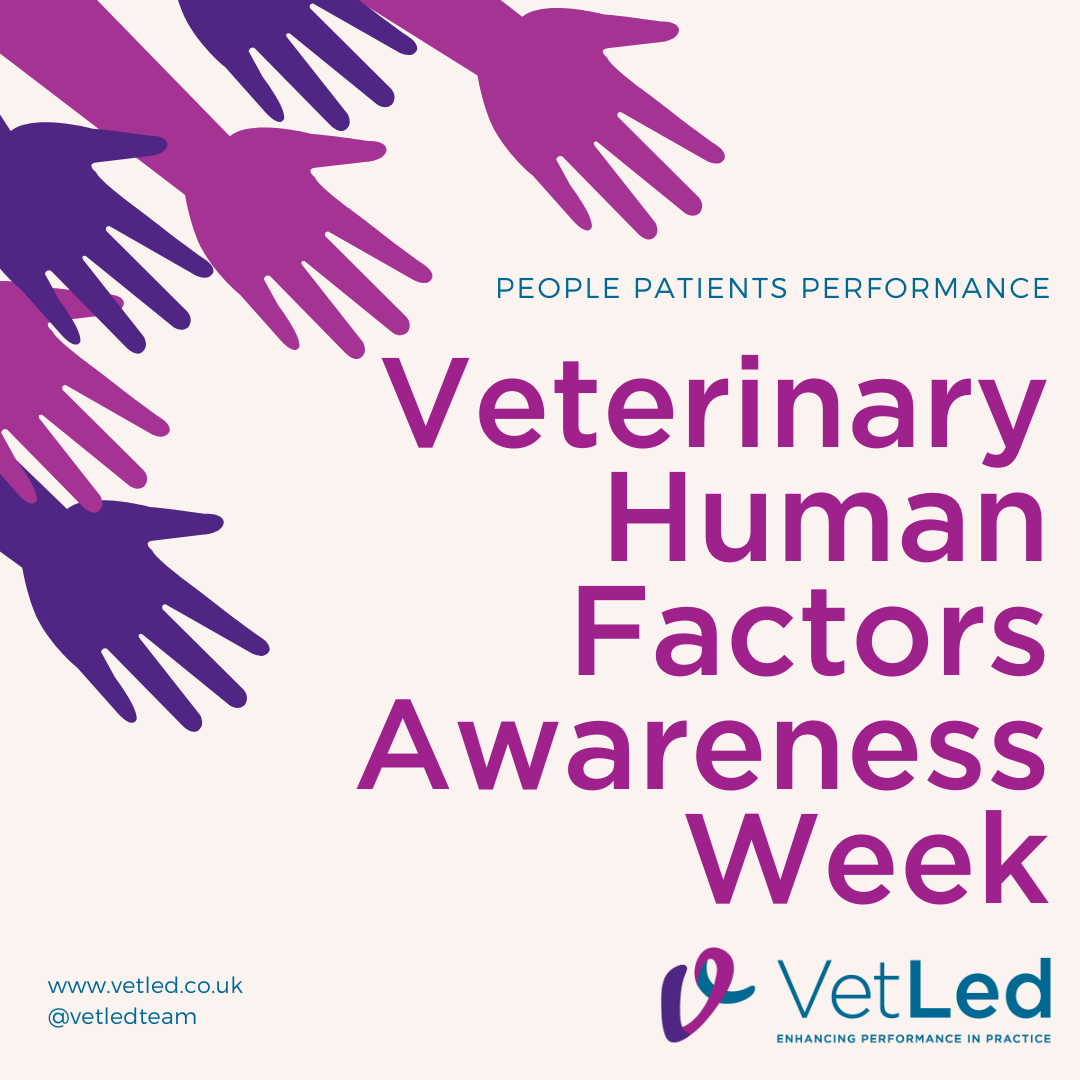
Every April, we run our Veterinary Human Factors Awareness Week campaign. During the week, we give an introduction to the basics of Human Factors principles, including how our behaviour and performance are impacted by the people and the environment around us, how we're feeling on the day, our clinical skills, our non-technical skills, the systems and processes we use at work, and the equipment and resources we have. There are so many interactions that influence the outcome of the work we do, and therefore patient safety. The campaign encourages veterinary teams to get curious about the value of non-technical skills and Human Factors training on their performance, and spread the word about the impact of improved workplace culture, team wellbeing, communication, leadership and team dynamics on patient safety and the people in our profession.

Throughout the week, we share research and evidence that demonstrates the importance of Human Factors training, run webinars and social media polls, and encourage discussions within our community and further afield. We also regularly run giveaways or offer promotional discounts on our bitesize e-learning course 'An Introduction to Veterinary Human Factors'
If you'd like to support our campaign, download our practice poster using the button at the top of the page and watch this space for our 2026 campaign dates.
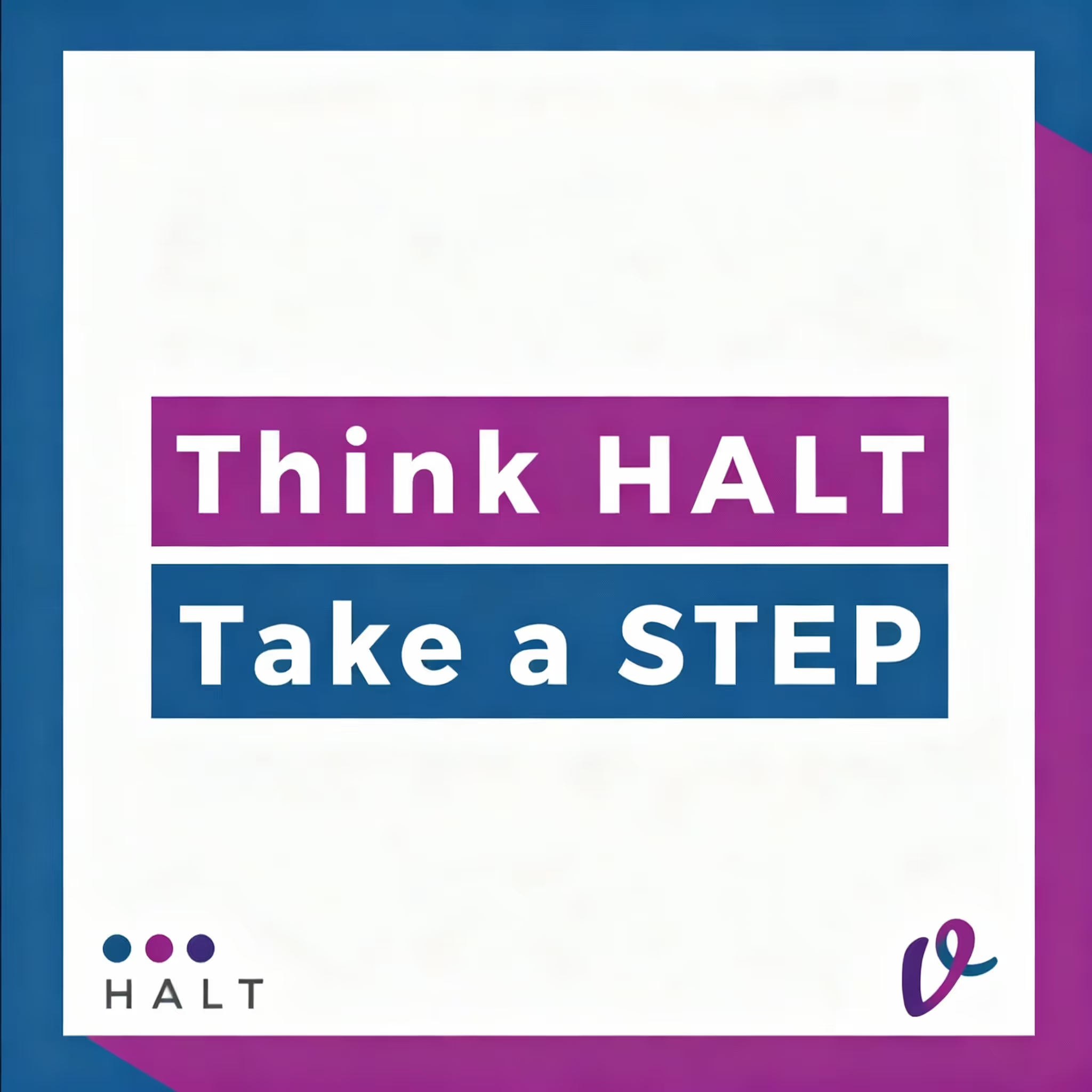
A simple tool that puts a spotlight on the physical and mental elements that commonly affect wellbeing and performance.
What is HALT?
HALT is a self-care acronym and reminder to pause — to plan and prioritise the daily breaks we all need. It highlights the key factors that can negatively affect wellbeing and performance:
- Hungry and/or Thirsty
- Angry and/or Anxious
- Late and/or Lonely
- Tired
These states make us more vulnerable to errors and stress. Recognising and addressing them helps improve focus, safety, and overall team performance.
Background
Inspired by a campaign from Guy’s & St Thomas’ NHS Foundation Trust, VetLed adapted HALT for the veterinary profession, recognising that vets experience similar pressures as human healthcare workers.
In collaboration with Dr. Mike Farquhar, Consultant in Sleep Medicine, the campaign reinforces the importance of physical and mental wellbeing in veterinary teams. VetLed’s vision is to inspire, create, and champion positive veterinary culture — for people, patients, and the profession.
“Unless critically ill patients require your immediate attention, our patients are always better served by clinicians who have had appropriate periods of rest during their shifts.”
— Dr. Mike Farquhar, Guy’s & St Thomas’ NHS Foundation Trust
Why HALT Matters
The HALT factors directly affect how we feel, function, and perform — influencing both patient safety and clinical quality. HALT encourages veterinary professionals to prioritise their own wellbeing alongside their patients’.
Self-care is anything but selfish.
The Three Ps: Plan, Prioritise, Pause
Implementing HALT effectively means making breaks part of daily structure:
- Plan – Schedule team breaks at the start of the day. Hold each other accountable.
- Prioritise – Short breaks improve performance, safety, and morale. Recognise HALT factors early.
- Pause – Actually take your break. Support each other. Leaders should lead by example.
Teams that are not hungry, tired, or anxious perform better, safer, and more productively.
How to Do It
Morning Huddle: Start each day with a short discussion involving the team to set expectations, share concerns, and build accountability.
Break Planning: Map out breaks early to make workloads more manageable.
Accountability: Check in with yourself and others — are you taking your breaks? Leaders can reinforce the culture by modelling this behaviour.
Conclusion
The HALT Campaign promotes simple, actionable steps to improve wellbeing and reduce error through rest, self-awareness, and teamwork. By embedding HALT into daily practice, teams build a safer, more supportive workplace culture.
For more information, visit vetled.co.uk or contact info@vetled.co.uk.
Follow: @VetLedteam on social media.

The last session on a Friday might be considered the graveyard slot by some, but for those fortunate enough to attend the workshop on ‘Managing Difficult Conversations with Clients’ from Sara Jackson of VetLed, it proved anything but.
Using principles of Nonviolent Communication, Dr Jackson encouraged a pause before responding in tricky or potentially threatening client interactions. Delegates were taught the framework of ‘observation, feelings, needs and requests’, a way of using ‘I’ statements to humanise the interaction between two seemingly opposed people that is much more likely to result in a civil and positive outcome.
The concept of being civil and polite is part of the VetLed ‘Civility Saves Lives’ campaign, which itself is part of a broader movement within healthcare globally looking at tackling incivility in the workplace. Evidence shows that being involved in or observing rudeness reduces feelings of safety for team members and ultimately negatively impacts patient care, and Dr Jackson illustrated this point with examples from her own career as an ECC advanced practitioner.
The interactive workshop allowed discussion of experiences with difficult client interactions with the opportunity to reflect on these with the example of the non-violent communication framework. The general consensus was that not only would this benefit work relationships but those at home too; one attendee happily stating that this had revolutionised his relationship with his wife!
The session finished with the acknowledgement that as vets, our feelings in the interactions were as important as the clients, an essential point as we look to combat the crisis of burnout in our profession. The hope is that with the practice of this communication strategy the escalation of potential conflict can be halted, and delegates left the session feeling buoyed by this new knowledge.
Please visit https://www.vetled.co.uk/civility for more information on this subject, and www.vetled.co.uk/book-online to find out how VetLed can help your practice team.
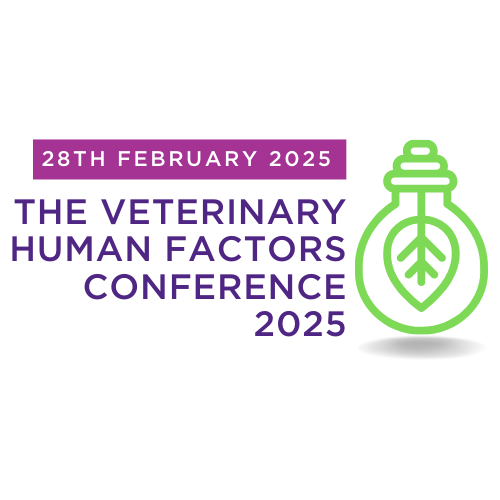
(This blog was first published on our previous website)
Our fifth Veterinary Human Factors Conference is challenging veterinary professionals worldwide to take a regenerative and restorative approach to veterinary practice
The overarching theme of our 2025 conference is how to make veterinary work sustainable, creating teams that can reliably work at their best, feel positive about work, and feel supported and valued by their team.
The newly released programme has three streams, each tailored to a group of delegates:
Stream 1 – Introduction to Human Factors
In the first stream, VetLed founder and Training Director, Dan Tipney will be joined by guest speakers, including Emma Tallini, Becky Jones, Sara Jackson, and Crina Dragu, vets and nurses with long experience in this area in practice, education, referral, and first opinion. These Human Factors champions will help delegates understand how they can make a difference to the way they work using tools and techniques that are proven and established in human medicine and other safety-critical professions. The key aim of this stream is not just to help delegates understand what Human Factors is and why it is helpful in veterinary work, but to make sure that they leave with tools and practical tips to form an action plan that applies to their practice, organisation, or team. These tools don’t just improve patient safety, which is an obvious priority in our caregiving profession, but they also help vets, nurses, and other veterinary staff feel happier and more confident at work, working more efficiently and safely, and achieving better wellbeing.
Stream 2 – Knowing Me, Knowing You
I'll be co-hosting the second stream with passionate human behaviour expert and impact-maker Katie Ford, taking delegates on a journey to understand themselves as humans, acknowledge and accommodate their own needs and the needs of others, and work better as a team. It’s so common in the veterinary profession for us to put our heads down and get on with the job in hand, but a wider understanding of ourselves and others as humans can make work a much happier place to be. We'll be joined by Vet Empowered, Petra Agthe, VetYogi, Affinity Futures, and VetLed’s Jenny Guyat, who will each share their unique slant and perspective on an aspect of self-awareness, compassion, being curious, and team dynamics. Together, they’ll share the science behind how our brains and bodies work, how we develop and sustain relationships, and how this affects how we feel and work as a team – giving delegates the power to change their experience of work for the better, and not just for them, but for the whole team.
Stream 3 – Delving Deeper
The third stream will be hosted by VetLed Managing Director, Cat Auden, and a Chartered Psychologist, Ergonomist, and Human Factors Specialist. Stream three allows delegates who are already familiar with Human Factors concepts to think big, share ideas, and shape the veterinary profession. With short TED talks from Suzette Woodward, Elly Russell, and Emma Cathcart, each followed by Q and A sessions, the stream will be highly interactive, encouraging collaboration, thought, and innovation.
Amanda Joy Oates - Cultivating Restorative Cultures, "helping you find joy at work". Board Director of Restorative Justice Culture Foundation

Keynote Speaker – Amanda Oates BA (hons), MSc Strategic HRD, C.C.I.P.D.
Restorative practice means better experiences for veterinary people, patients, practices, and the profession. The concept of restorative veterinary practice relies on establishing a restorative workplace culture, an area that the Veterinary Human Factors Conference 2025 Keynote Speaker, Amanda Oates is passionate about. Amanda was Chief People & Culture Officer and Deputy CEO at Mersey Care NHS Trust, and now runs her own HR consultancy around cultivating restorative cultures.
Previous conference feedback:
‘Really enjoyed the networking sessions, this was a great opportunity to share learnings, alongside the lectures which were great with a huge variety of content. Absolutely fantastic conference again, well done to the VetLed Team!’
2024 Delegate
‘I was absolutely blown away by the event. I’m 20 years qualified and never done any non-clinical CPD or really considered human factors. I recently had a period of burnout due to high workload, hormonal issues and lack of self-care. My practice manager booked me on the conference and I had low expectations. I have had multiple light bulb moments. I’m still working my way through the content but I’m so inspired by everyone that I think this could have unlocked a new passion in me.’
2024 Delegate
Here's what Cat Auden had to say about the conference:
“I’m so proud of how the VetLed conference uniquely addresses the critical intersection of clinical excellence with the science of how humans work. We seek to equip attendees with practical tools to enhance all angles of human performance and wellbeing ultimately resulting in better patient outcomes.
At VetLed, we know that investing in Human Factors training is the key to building sustainable, high-performing teams and delivering the best possible care to both animals and their owners. Every year I love witnessing delegates’ ‘lightbulb moments’ at the conference, as they discover eye-opening, fresh perspectives and practical strategies that genuinely transform the way they work back in their practices."— Dr Cat Auden MRCVS, Managing Director, VetLed
You can book a discovery call at https://vetled.co.uk/book-online or find out more about the conference at https://www.vetled.co.uk/conference

This blog was written by Vasiliki Bitou DVM MRCVS on behalf of the VetLed team.
A scenario where all employees return from work happier than they came in the morning is not a dream, it's achievable. But, as leaders, where do you start?
There is a correlation between happiness and engagement in the workplace. Happiness brings emotional energy but can lead to unfocused employees. In contrast, engagement brings purpose and clarity but can create a competitive environment. The key is balancing happiness and engagement to achieve a productive and positive workplace. After all, no practice will be successful in the long term without prioritising team engagement.
In this blog, we explore how to keep your team engaged with company values and happy at work.
Connecting with the Bigger Picture
One of the main reasons employees in the wider world of workplaces feel disengaged is because they are only involved in specific parts of the production process and not engaged with the final product. This can make their work feel fragmented and less meaningful. In the veterinary profession, we are fortunate because most employees are invested in the patient from start to finish. This direct involvement in the outcome is a unique advantage. However, to take engagement one step further, it is crucial to proactively remind each employee of the vital role they play in the overall process. Each team member should understand where they fit in the bigger picture and why their job matters. The higher their level of engagement, the better their job satisfaction.
Establishing the worth of every employee and justifying why their job is unique is the first step, but the next step is empowerment. Allowing your team to make decisions gets them involved. It is not about telling them how to do things - "your way" isn't the only way. Although letting your team make mistakes and learn from them might feel risky and uncertain, even as an experienced manager, being supportive, approachable, and withholding unnecessary judgement, thereby creating a psychologically safe workplace will promote individual and team growth. Creating plans and problem-solving is essential for feeling productive, involved, and engaged.
Quality coaching
‘As a leader, your role is to engage your team not only in identifying the problems but in thinking about solutions.’
Employees need regular one-to-one meetings, including performance reviews, opportunities to receive recognition as well as, foundationally, building strong working relationship with senior members of the team. Remember that your team members experience any problems and inefficiencies with practice life first-hand. Acknowledging their ideas and validating their perspectives helps to nurture your relationship and positively changes your practice culture. On the other hand, not allowing your team to express their struggles, irritations and, on the flipside, their ideas, will frequently lead to poor team wellbeing, burnout, and loss of staff. As a leader, your role is to engage your team not only in identifying the problems but in thinking about solutions. Their problem-solving skills are like muscles - the less they’re used, the weaker they become.
Beyond the Payslip
Salary is important, but a good salary alone won’t guarantee happy, engaged, and productive staff. In this modern world dominated by specialisation and competitiveness, employees want to grow and develop their knowledge and skills. Providing clear and constructive feedback and ensuring that employees understand areas for improvement and how they align with company values and goals is crucial. Additionally, offering CPD and training opportunities is essential, including vet and vet nurse professional development and non-clinical team members’ training programs. Creating ‘guidelines’ to promote work-life balance (e.g., no emails after work hours) and ring-fencing time inside work for breaks, and outside of work for socialising, hobbies and rest is important to foster team spirit and improve mental health.
The Next Step
Working within the veterinary vocation requires those who practice to bring a great deal of themselves to the job. With that comes vulnerability and the need to prioritise our wellbeing, but it also gives us the power as both leaders, and as employees, to shape the future of the profession we love. If you’re a leader who wants a happier, healthier, and more productive team, join the VetLed Leadership Programme. which is now available to individuals as well as groups of leaders from the same practice. Find out more at www.vetled.co.uk/leadership.
What makes a good leader? – Summary
- Balance team happiness and engagement to increase productivity and improve workplace culture
- Help your team see their role in the bigger picture – share your vision
- Empower your team to make decisions
- Support your team to grow following mistakes, without judgement or shame

The Perception of Time in Our Profession
Time is a curious thing, especially in the veterinary profession. How often do we pause during our ten-hour workdays to consider our progress and what we’ve achieved? By the end of the day, we might not even remember how many people and animals we’ve helped and interacted with, or the details of what happened. Was Charlie the dog or the cat? Did they have the corneal ulcer or the UTI?
Day-to-day life in the veterinary industry can be hectic, and over time, this can contribute to fatigue and mental health challenges. This article explores how we perceive time in a high-pressure environment and the potential effects on Patient Safety. It also offers strategies to make the most of our time at work and highlights the benefits of taking a break, both at work and outside of it.
Time Flies: Losing Track of Time
Time Perception: From Pressure to Purpose
In the fast-paced world of veterinary care, time often feels like an enemy. But what if we could shift our perception of time, turning it from a source of pressure into an opportunity for qualitative improvement? Whilst this may seem at odds with 15 or 20-minute consult slots, there’s value in slowing down, becoming more conscious of our actions, actively interacting with clients and seeing our work not just as a series of tasks, but as a form of care and nourishment for ourselves. Setting targets throughout the day that focus on good care of self as well as good patient care will help keep you focused and prevent overwhelm.
As our profession has a caregiving nature, it’s essential to first care for ourselves and our teams. If we don’t, we’re less able to truly help those who rely on us. We don’t need to be perfect machines that produce diagnoses; instead, we should strive to be natural and, crucially, to educate our clients about what they should expect from the process.
The Relativity of Time in Veterinary Practice
How long has this dog been under anesthesia? How long have we been unable to intubate for? How much time has passed as I try to take blood from this anxious cat? Every veterinary professional has experienced the relativity of time—where minutes stretch or shrink depending on the task at hand. As task-oriented individuals, we often focus on completing tasks at all costs, which can sometimes have catastrophic consequences for our patients.
Take the story of Elaine Bromiley as an example. She went into the hospital for a routine sinus operation and during anaesthetic induction, major complications arose. Her airway obstructed and the team was unable to gain a secure airway. For 20 minutes they attempted to achieve a stable airway, during which time her oxygen saturations were around 40%., Though she survived the initial crisis, Elaine suffered severe hypoxic brain injury and, 13 days later, her life support was turned off.
This tragedy highlights how time pressure and communication breakdowns can lead to fatal outcomes. Elaine's story demonstrates an opportunity for improvement via a Human Factors approach, including the use of systems and processes and fostering psychological safety in the workplace, to prevent these kinds of incidents.
Efficiency of Time
In a time-pressured environment like veterinary practice, systems and processes are key to improving efficiency and reducing errors. Tools such as checklists, safety protocols, and structured handovers are invaluable—although often viewed as an extra burden when first introduced.
Despite being a piece of paper, checklists are so much more. They are simple, easy to follow, and evidence based tools that can significantly improve team coordination. They ensure that a large group of staff can work together smoothly, even under pressure, while keeping adverse event rates low.
According to the WHO checklists study, in 2010 in hospitals in both high and lower income settings in eight cities around the world: "Analysis shows that the rate of major complications following surgery fell from 11% in the baseline period to 7% after introduction of the checklist, a reduction of one third. Inpatient deaths following major operations fell by more than 40% (from 1.5% to 0.8%).”
Checklists and similar tools turn autonomy into heteronomy
While autonomy requires individuals to make their own decisions, the collective nature of veterinary work demands a more structured approach. We all experience unreliable memory recall and limited attention spans, especially in stressful, complex environments where multiple tasks must be managed simultaneously. This reality increases the risk of overlooking critical details, potentially leading to serious consequences.
Moreover, when managing large volumes of tasks - such as the reality of the prep-room: Four inpatients, an animal under general anaesthetic, and members of staff looking for guidance in three different tasks- it's easy to omit basic but crucial safety steps. Even highly experienced professionals are prone to making mistakes. In fact, their expertise might make them more likely to overlook details, believing they can handle any situation. Heteronomy, through tools like checklists, helps to account for human limitations by providing external guidance. Though checklists may initially seem monotonous, patronising and time-consuming, they ultimately save time by providing a clear strategy, assigning specific roles and improving team collaboration.. These tools have been found to enhance efficiency, reducing the likelihood of mistakes that could require significant time to correct—or worse, be irreversible.
How to Escape Time (using Human Factors tools)
How often do you feel the need to step away, take a break, and reboot your system? In the fast-paced world of veterinary care, we have all experienced the feeling that time cannot wait. While we can’t always control the flow of time, we can change how we approach it.
Consider the concept of HALT (Hungry, Angry, Lonely, Tired). While these states seem straightforward, it can be easy to ignore them. The instinct to achieve our goals often outweighs the logical need to stay hydrated, take breaks, or address stress. This can contribute to a workplace culture of “pushing on regardless”, and is compounded when teams witness leaders or colleagues skip their breaks. But recognising these needs, communicating them, and taking a break is crucial. It is absolutely okay to pause and recharge.
Time Off Work
We can't operate at 100% all the time. It's important to accept that it's perfectly fine to enjoy down-time when you’re off the clock. Rest is a valuable tool and essential to our wellbeing and performance. Our brains are highly adaptable, and while they might struggle to slow down after a high-paced day at work, neuroplasticity allows us to retrain our minds to truly relax. Whatever relaxation means to you—whether it's reading a book, taking a walk, or simply doing nothing—it’s vital to embrace it without guilt. Remember, there’s no right or wrong way to spend your time.
Help your team use their time ‘well’ – make wellbeing a priority
VetLed’s HALT resources are a great way to promote wellbeing within your team - with posters and other tools to act as reminders and conversation starters. If you’re interested in implementing HALT, but daunted by the task of changing a well-established workplace culture of ‘just getting on with it,’ let VetLed support you to create the change you’d like to see. Browse our veterinary team training workshops, including wellbeing and culture topics, book an in-practice workshop on Human Factors foundations to help get your team on board, or use a practice observation day to find the best areas to focus.
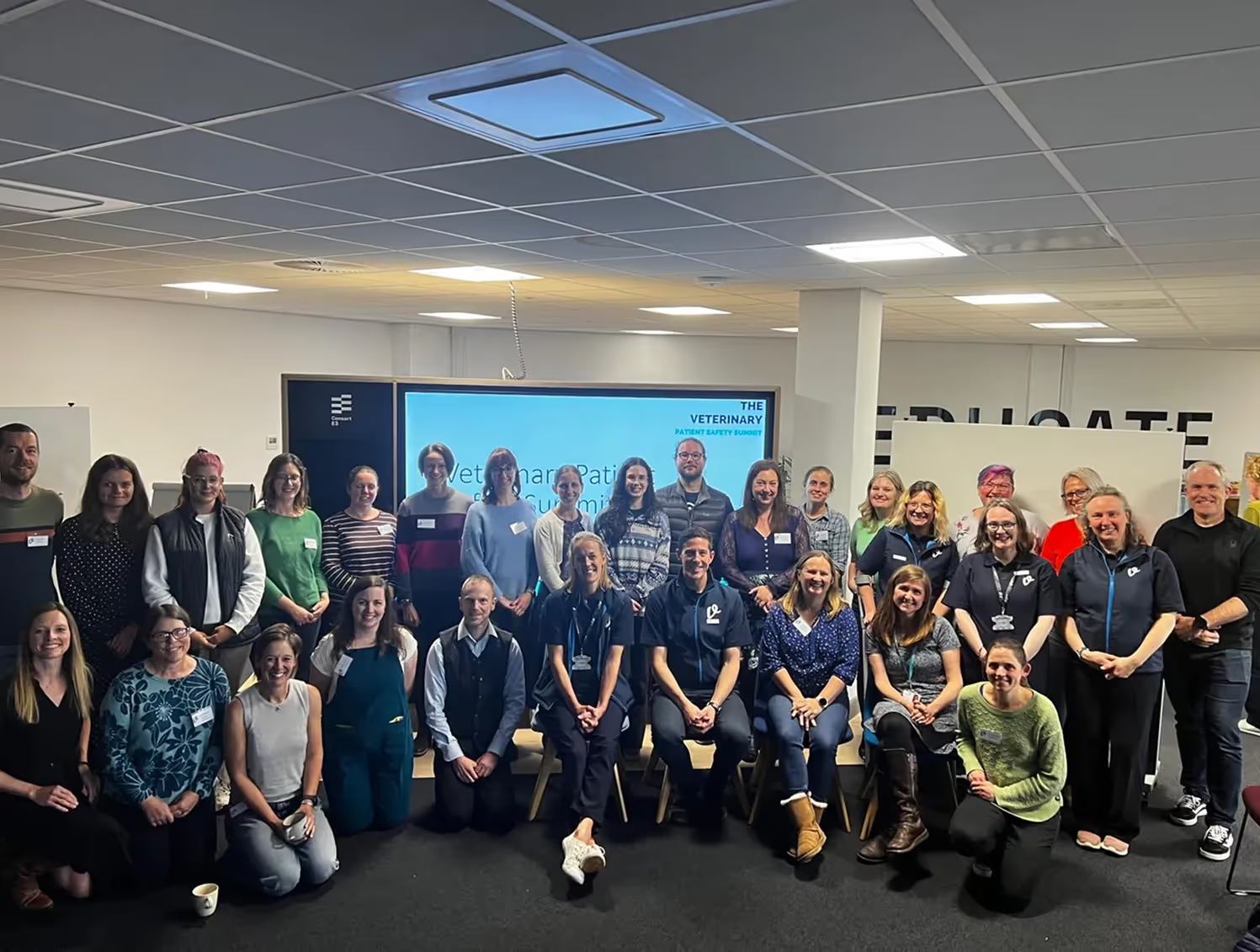
(This blog post was first published on our previous website)
Last Friday, the 11th of October, we were again joined by curious and passionate individuals from the veterinary community, at the Veterinary Patient Safety Summit 2024. For our third year running this event, we were aiming high. After all, to make a real positive impact we need to spread the word out into frontline practices, as Cat Auden said in the welcome session:
‘Once we can get 45% of the veterinary population saying “Yes, this matters”, we know we can make a real difference.’
Cat Auden, VetLed
VetLed Managing Director, Cat Auden, welcoming delegates at VPSS 2024
Therefore, we wanted to meet new patient safety champions and benefit from the insights and experiences of those leading the field. So, when the setting up and morning organisation were done and people started to arrive, we were excited to greet a real mixture of vets and vet nurses from different backgrounds and holding various positions. It was great to reconnect with two vet nurses who had attended VetLed training in April, and we were delighted to meet a range of practice owners from independent practices across the UK and senior corporate leads in Quality Improvement and Clinical Governence. From the moment people walked through the door, there was a real buzz as they greeted old friends and began conversations with new connections. This inclusive atmosphere lent itself to a safe space for all to share, no matter their practice background.
What did the day look like?
The event was held at the Consort E3 Lab, set within Harper and Keele Vet School. This versatile, ultra-modern learning space allowed us real freedom to deliver the sessions however we wanted. It was nice to have a balance of informal, sit-down lectures, with interactive polls and Q and A's, combined with brainstorming tasks completed in rotating small groups. Even coffee breaks and lunch were a time to continue conversations, and this talking time was really valued by the delegates and VetLed team. Hamish Morrin, one of our associate trainers, was brimming with enthusiasm when he shared how much he’d enjoyed chatting to delegates about regenerative and restorative practice.
The Great Veterinary Patient Safety Think Tank
One of the delegates acting as scribe for his group during the Great Veterinary Patient Safety Think Tank
With so many diverse and valued people in the room with the knowledge to share, we knew it was an opportunity to collaborate and contribute to overcoming the barriers to Patient Safety. So, we set up the Great VPS Think Tank, where delegates moved in small groups to different magic wall (Yes, we could write on the wall!) stations, answering the following questions. If you’re running a veterinary practice or organisation, take note:
- One thing I would like to see across the profession that would make the biggest difference for patient outcomes is…
In this discussion, it was great to see where different groups placed their emphasis. For instance, one group focused on the importance of a positive workplace culture, where leaders set examples, hierarchy is shallowed (where appropriate), and openness around mistakes, concerns, and near misses is encouraged or rewarded. The role of standard processes, like checklists, was also highlighted. However, another group felt the key to answering the question lay elsewhere – in commitment to and financial investment in Patient Safety across the profession. A third group added that educating the next generation of vets and nurses was another opportunity for positive change.
- My biggest current challenge with achieving what I want for my patients is…
As you might expect, one of the challenges that came up during this discussion was time or lack thereof. This lack of time prevents appropriate reflection on cases and their outcomes, even though time invested in reflection is recouped later through lack of error and better productivity. Lack of time is also an obstacle to meeting our physiological needs by taking adequate breaks. But this wasn't the only identified challenge. Conflicting goals and mismatched risk tolerance between clients and veterinary staff, the public perception of our profession (fuelled by the media), client behaviour, and differences in communication style between clients and within the team were just a few of the answers our small groups suggested.
- When I think about error, I think about…
The ideas around this question had two main streams. First, the emotional reaction, including 'that gut feeling', self-blame, trauma, and the fear of judgement. However, this was followed by a proactive and positive approach, highlighting the importance of curiosity, a Just Culture, debriefing, and a non-judgemental approach. During these conversations, delegates spoke about the importance of checking in with the person or people affected, using appropriate language and communication styles that avoid blame and shame, and considering the acronym ‘FAIL’ – ‘first attempt in learning.’ Perhaps one of the nicest responses we saw, though, was ‘VDS’ written on the wall, surrounded by a heart – an important reminder to get support and guidance when you need it.
Who were the speakers at VPSS 2024?
Pam Mosedale – RCVS Knowledge
Pam gave a fantastic overview of how we can support Patient Safety in practice through audits and research. She acknowledged the frustration leaders feel when they put effort into creating guidelines, only for them to be ignored. As a response to this, she highlighted the importance of involving the whole team in Quality Improvement efforts when she said:
‘It’s like the man at NASA sweeping the floor – when asked “What do you do?” he replies, “I send men to the moon”’
Pam Mosedale, RCVS Knowledge
Pam Mosedale, from RCVS Knowledge invited thoughts from delegates during her session on the importance of audits and research
Alongside promoting a whole team approach to audits and research, Pam also spread awareness of supporting resources, including the RCVS Knowledge Library, their journal watch system, inFOCUS, international audits, and benchmarking tools.
Catherine Oxtoby – Veterinary Defence Society
We were pleased to be joined by Catherine Oxtoby, from the VDS, who tagged into Pam's session 'Patient Safety – Where's the evidence?' Catherine opened her section by pointing out how far the profession has already come in terms of response to mistakes and adverse events, both in terms of non-clinical topics being firmly on the agenda at vet conferences, but also in how we talk about error:
‘When I messed up in practice, we didn’t talk about it.’
Catherine Oxtoby, VDS
Catherine Oxtoby, from the VDS, shared her enthusiasm for veterinary research with delegates
Since Catherine has moved from clinical practice, there’s been a shift in how we respond to errors. Higher levels of psychological safety mean that mistakes are more likely to be discussed, the people involved asked whether they're okay, and a curious approach adopted to find out what can be learned going forward. Of course, there's still plenty of room for improvement, and different teams will be doing this well, or less well. Finally, Catherine closed by highlighting the benefit of events like VPSS 2024 in bringing practicing vets and vet nurses with a research interest together with current researchers, allowing an opportunity for collaboration and support. She encouraged delegates to get involved in research, inviting them to find what makes them curious or annoyed in practice and use that as a focus for research or audits.
Sara Jackson – VetLed
During her talk, ‘Is Human Error Ever Truly a Cause of an Unexpected Outcome?’, Sara encouraged interactivity via Slido polls. She bravely shared her own experiences in practice, and how they’ve shaped her approach to mistakes within her team, which can be summarised with this quote:
‘Okay, I’ve made an error. What am I going to learn?’
Sara Jackson, VetLed Associate Trainer
VetLed Associate Trainer, Sara Jackson, addressing delegates during her session at VPSS 2024
She highlighted the importance of language, questioning whether the term ‘error’ might perpetuate a blame culture and pointing out that the term ‘unexpected outcome’ is widely understood as a negative when actually, outcomes can also be unexpectedly good! The language theme continued when she acknowledged the barrier posed by the term ‘leader’. Sara pointed out that some people are excellent leaders in practice, but don’t view themselves as leaders, meaning it can be hard to reach them. Using other terms and titles, like ‘Coordinator’ rather than ‘Lead’ may break down this barrier and be helpful for those who don’t self-identify as leaders.
Emma Cathcart – VetSafe
Constructive reporting was the theme of Emma's session. She used one of her own experiences as an intern to demonstrate not only the importance of learning from mistakes as a team but also of sharing this knowledge with others. This prevents new staff from making the same mistake but also means we can learn and progress as a profession, which is really powerful. During her talk, Emma showcased the power of incident reporting by saying:
‘Incident reporting is like a black box recorder. It helps us figure out what was going on in the moment.’
Emma Cathcart
Emma Cathcart, from VetSafe, speaking at VPSS 2024
Incident reporting can be a local, single practice system, like an 'oops book', but it's most useful when this information is reported nationwide, providing data for research and improvements that can be shared throughout the profession and to other safety-critical professions. VetSafe, the nationwide incident reporting system, is relaunching in November and you can find out more at https://vetsafe.org.
Dan Tipney – VetLed
To begin his session on restorative and regenerative veterinary practice, Dan opened by describing a forest – a natural restorative system. The brambles serve to protect fragile saplings, until they grow stronger and overtake the brambles. Fallen trees let more light in and are broken down, feeding into the soil and providing further opportunities for new growth. This process of continually renewing itself can be applied to veterinary practice too, and is particularly applicable to working things through after an unexpected outcome and going forward afterwards. However, Dan pointed out that it takes a commitment to restorative actions, including addressing imbalances caused by not meeting the needs of the team, but there needs to be a balance between learning and accountability.
VetLed Training Director, Dan Tipney, contributing to conversations at VPSS 2024
‘Who is to blame is not a particularly helpful place to start when something goes wrong. Instead, ask “How do we stop that from happening again?” ’
Dan Tipney, VetLed
Further questions suggested by Dan that should be posed when faced with mistakes or adverse events include:
- Who was hurt?
- What do they need?
- Whose obligation is it to meet that need?
By asking these questions, it puts the focus on rebuilding and repairing, creating motivation for positive action, and providing support. Dan provided realistic actions that could be implemented in practice, like Schwartz rounds, celebrating and understanding success, surveys, focus groups, and changes in language toward 'non-routine event' or 'event' rather than 'error' or 'adverse event.' In turn, these actions improve team wellbeing and satisfaction, as well as providing opportunities to look closer at the way we work and make improvements. Finally, Dan closed his session by highlighting the potential of restorative veterinary practice and its benefit to people, patients, practices, and the whole profession.
The power of conversation
Aside from the knowledge gained during the organised sessions, the value of tips and snippets shared during informal conversations throughout the day cannot be underestimated. So many delegates have praised the format of VPSS 2024 and how it facilitated learning from everyone in a safe and inclusive space.
What was the feedback?
The feedback that we have received has been overwhelmingly positive. Not only are people celebrating the power of meeting in person at VPSS 2024 and the work that we are doing at VetLed, but they are also sharing the changes that they’ve already made as a result of attending. Here is just a small sample of the feedback we’ve had already:
'My 1st and 2nd year tutorial groups started with Gratitudes this morning (and a chat about Human Factors and Civility Saves Lives). Thanks for the inspiration, Fiona Leathers.'
Jenny Powell, HKVS
'I've come away feeling so much more positive about the veterinary industry. I found myself saying 'That makes me so happy!' many, many times when listening to what people are doing in their work.'
Steph Ivers, Sunflower Veterinary Services
‘Another amazing event by VetLed!’
Louise Grieve, Veterinary Specialists Scotland
‘As with previous VetLed stuff, it has given me more/renewed enthusiasm to take the Human Factors/QI/Patient Safety stuff and keep it going in the practice’
Katie McCreary, Hook Norton Veterinary Group
What next?
Whether you attended VPSS this year or not, we know you want to create better experiences for the vets, nurses, and non-clinical staff you work with - not to mention your patients!
If that's you, visit https://vetled.co.uk/book-online to book a discovery call with one of our team, and let us help you find training that suits you.
Don't forget that we offer:
- Training workshops
- Observation days
- A Leadership Programme
- The Veterinary Human Factors Conference 2025
We hope to see you all at the Veterinary Patient Safety Summit next year!

When asked what makes a high-performing team, what would you say? I’m sure many people would say that having the best skills or most talented individuals on the team would lead to the best performance.
However a massive study conducted by Google in 2015 showed that:
“who is on a team matters less than how the team members interact, structure their work, and view their contributions”[GOO19].
So in the veterinary context, our clinical skills and combined IQs can only get us so far in terms of performance as a practice. We hit a metaphorical performance glass ceiling.
The study at Google demonstrated that 5 key factors set the most successful teams apart from the others.
- Psychological safety – can team members take risks without feeling insecure or embarrassed?
- Dependability – Can team members rely on one another to do high quality work on time?
- Structure and clarity – Are goals, roles and execution plans clear for our team?
- Meaning of work – Is our work something that is personally important for each of us?
- Impact of work – Do we believe that the work we’re doing matters? [GOO19]
So the number one factor present in a high-performing team? Psychological safety. And furthermore, this factor underpins each of the subsequent four factors.
What Does Psychological Safety Mean?
Psychological safety is the creation of an environment in which all team members are safe, and feel safe, to take interpersonal risk to speak up without fear of judgement or animosity from colleagues.
This may be with a new idea, halting a process that may be dangerous, admission of a need for help, offering constructive feedback or adding opposing opinions to a discussion no matter what level of the team hierarchy the contributor is, amongst myriad other things. Data from Gallup [GALL17] polls show that in the US, only 3 out of 10 workers feel it is safe to speak up at work. But there is hard data showing that productivity and turnover increase (12% and 27% respectively) and safety incidents drop (by 40%) simply by increasing how many workers feel their opinions matter. As a high-performance workplace and as a business we are losing enormous value if our team don’t feel psychologically safe.
“If we’re not hearing from people we may be missing out on a game-changing idea…or we might miss an early warning…that someone saw but felt unable to bring the bad news to their boss.”
So how does a team create an environment of psychological safety? Is it as simple as being led by someone who is nice, kind, humble, helpful and authentic? Well in short, no. Building psychological safety and trust in a workplace isn’t as simple as just being the ‘nice guy’. Research has shown that there is greater trust when we identify with people in the same group, particularly if the purpose of the group is something we care about fundamentally. Hence the way that points 4 and 5 above underpin the level of psychological safety in our own veterinary workplaces. Do our team members feel that the work they do as individuals is personally important to them? Do they believe that the work they are doing matters? If as a team we are all feeling the same about these issues, then an environment of psychological safety starts to build.
The following statements were used by Prof Amy Edmondson (who coined the term psychological safety) to survey how employees felt about the psychological safety in their team. What would you answer?
How Does Psychological Safety Relate To Just Culture?
Just Culture refers to a workplace culture that recognises that competent professionals make mistakes and can also simply develop unhealthy norms. This is normal and can be treated as something to learn and grow from as a whole team. However, it is not a culture that allows for things like reckless behaviour or destructive acts. Team members are rightly held accountable for this sort of behaviour. But unlike a blame culture, a Just Culture focuses on systems-based issues that could lead to a genuine mistake. It does not just focus on the individual and their ultimate error. There is a shared accountability between the organisation (practice) for the systems in place that have contributed to the error and the employee who is accountable for his/her choices and equally for reporting their error. A psychologically safe workplace with a Just Culture is one in which team members can safely speak up about their errors or even practice/systems issues that could or have led to error, knowing that the situation will be dealt with fairly and justly. We must recognise all humans will make mistakes and often it is systems that lead to that human erring. A workplace where people feel psychologically safe will be a workplace where error is reported. In a Just Culture, that report is then dealt with in a just and fair manner and lessons are learned by the whole organisation not just the individual involved.
In all our practices there will have been a time where a client walked out the door with the wrong drug. It would be easy to point the finger at an individual and consider the situation dealt with. The vet must have pulled the wrong drug off the shelf, and should have taken more care to get it right. But on unpicking the situation we see that that day consults were full and some had been double booked. There was chaos in the dispensary because the drug order had arrived late so there was no time to fully unpack before afternoon consults. The label printer often spills labels out onto the floor if lots are printed at once. And a new SVN who was trying to help ease the load on the vets by labelling dispensed drugs, had only arrived that morning and hadn’t had a proper induction yet. A blame culture points the finger at an individual (vet or SVN) and considers the matter closed.
A Just Culture recognises that there were many issues at stake here and ultimately a mistake was made. It was largely systems error that was involved. A psychologically safe workplace means that the vet and hopefully even the brand new SVN can speak up and talk about what happened and why perhaps it happened without fear of retribution. The aims of dealing with an error are restoration not retribution. All parties can discuss how they have been affected with the aim of mitigating against a “second victim” where the individual involved also suffers through guilt, shame or blame.
A practice where it is safe to err will ultimately perform better in terms of patient safety, staff wellbeing, client care and much more. As a result there is better client satisfaction, lower staff turnover, reduced disciplinaries and greater dissemination of learning across the practice. In one NHS trust (NHS MerseyCare) where a Just and Learning Culture was implemented, within less than three years disciplinary cases amongst staff members were reduced by 75%, there was a significant increase in patient safety and a positive increase in staff satisfaction survey results.
This surely forms the foundations of a workplace we would all want to be in.
What Can We Do To Foster Psychological Safety In Practice?
Amy Edmondson, Novartis Professor of Leadership and Management at Harvard Business School.
1. Frame the work as a learning problem, not an execution problem
2. Acknowledge your own fallibility.
3. Model curiosity and ask lots of questions (all levels of team hierarchy)
Any surgical or medical procedure is easily viewed as a set of fixed problems (that we may or may not anticipate) to be met and executed. But framing the procedure or work up as a learning problem which the team all work through together changes our mindset altogether. If we are all approaching the case as a learning activity, then when issues arise it is far safer for any member of the team to speak up/make suggestions/ask a question.
- We need a team commitment to openness and safety in speaking up, not just with error and mistakes but with ideas and questions too. “We are all going to commit to being open with one another no matter who we are in the team. This is a group commitment not just theoretical thinking.”
- We need colleagues who are willing to hear from their team-mates. “I may have missed something so I need to hear from you”
- Questions can be from any member of the team to another regardless of position. Be curious about one another’s roles. “Why do you do it that way? What have you tried before that led you to doing things this way?” Model questioning with curiosity, not condemnation.
What Is Required For Psychological Safety To Become Part Of Our Workplace?
Leaders at all levels of the organisation need to recognise where they could make it easier for team members to approach them. This takes some humility. It is important for the leader in that environment to go first and do what they can to create psychological safety.
“What could I do to make you feel you can come to me with ideas, problems, opportunities and dangers?”
As an employee it’s often not easy to speak up is it? No-one goes to work wanting to look incompetent, ignorant, intrusive or negative. So how to avoid this? Well, keep quiet. Keeping quiet works to protect you, at least in the short-term. But it doesn’t protect or develop the team. The problem comes back – workplaces where teams don’t speak up/offer ideas/ask questions are lower performing, less successful, and are less profitable! Furthermore, not speaking up stalls learning, development and innovation in the team.
Take an example from human healthcare. Do better hospital teams make fewer medication errors? Research by Amy Edmondson [BUI14] showed initially that better teams made more mistakes, the opposite of what she had been expecting. It became clear on further research though that the better teams are not making more mistakes, but have a culture where they are more willing to admit and are open to discuss their mistakes…and as such are a better performing team.
Is it worth developing our workplace psychological safety? Absolutely.
Better team.
Better environment.
Better results for patients.
Better bottom line.
It’s a no brainer.
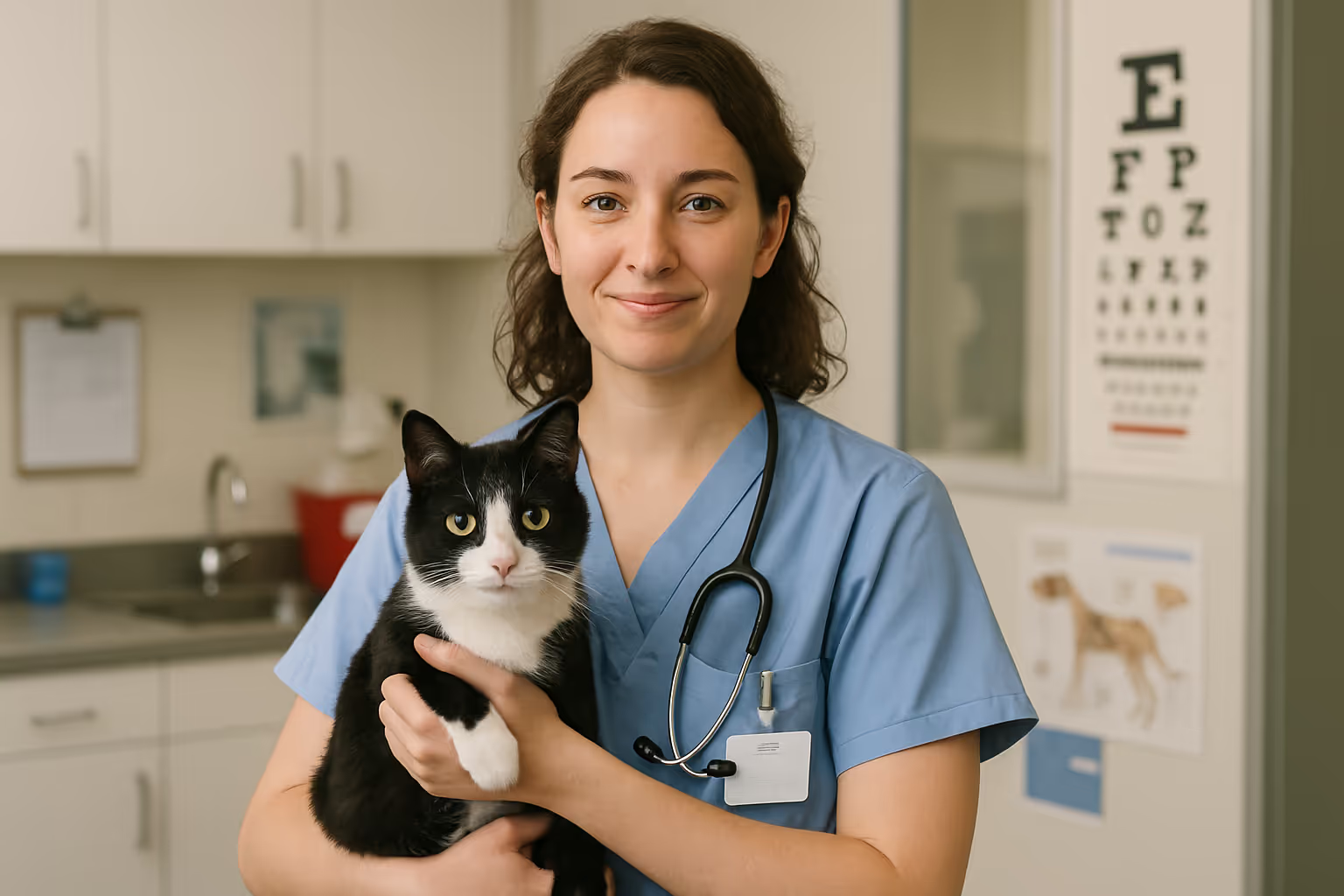
(The fourth in a series on developing safety in general practice from Catherine Auden at VetLed, first published on our previous website)
I know what it’s like.
There’s a lot of learning at vet school.
With the increasing availability of information via the web, online journals, blogs and social media, you could be digesting information from the moment you open your eyes until you fall into bed again that night.
So why read about Human Factors? You’re studying animals after all.
Perhaps you’ve thought a bit about people skills, communication and teamwork and suchlike and how this will impact you in veterinary practice? This is a good place to start but there’s more to it. All sorts of factors impact not only how we work but also how well we work.
As a new or soon-to-graduate vet, it is easy to focus heavily on your clinical skills. And yes, of course, none of us would disagree that these are super-important. But is there a disconnect between having great clinical skills, and actually delivering them?
Human factors bridge the gap between your clinical skills and your delivery of these skills.
Research shows that “basic cognitive limits have been identified as one of the leading causes of adverse events in medicine” [OXT15]. In fact, in 1991, studies at Harvard University [BRE91] published data showing that 98 000 patients per year were dying, not as a result of their condition but due to doctors’ mistakes. Further research published in 2000 by Kohn et al demonstrated that such error was not necessarily a result of professional negligence or even carelessness, but error made by capable medics. They were erring simply due to their own cognitive limitations and factors external to them in the environment in which they worked [KOH20]. As such it was publicly recognised that medical error was not simply a professional making a mistake that they could have “tried harder” not to have made, but a multi-factorial situation with myriad human factors involved.
This sort of data means we should all be pricking up our ears when it comes to the impact of HF on our own work. The field of veterinary human factors is growing but still in its infancy by comparison to the human medical world. We need to be aware of human factors as we work in veterinary practice and mitigate against the errors we could make, whether 20 days, or 20 years qualified.
"Experience is simply the name we give our mistakes"
Oscar Wilde
Under pressure
How we are wired as human beings will impact how we react in certain scenarios. Throw in a few other human beings, wired as differently and uniquely as us and the situation becomes more complex. Add stress, time pressure, a busy day and a new surgical procedure and we see how simply completing a surgical procedure is only one factor in many that will affect our performance and thus the standard of care we can deliver to our patients!
Human factors are an integral part of you and those around you. Human factors will affect how you work. Disregard them at your peril!
Viewed wrongly, an awareness of these factors might add to the stress we feel as new graduates, but in actual fact, being aware of the factors that affect our performance means that we can take steps to manage them, thus reducing mistakes.
So what are Human Factors and how can we manage them as we step into the world of veterinary practice?
It’s a huge topic worthy of a degree course in itself but factors that even on day 1 in practice you will be familiar with such as fatigue, stress, cognitive limitations, team dynamics and much more will all impact on our ability to deliver best patient care, despite our great knowledge and skills.
In fact, cognitive limitations and poor non-technical skills, both key elements within Human Factors, have been shown to cause the majority of errors in veterinary practice.
“Sustained high performance has its basis in learning and improvement”.
VetLed 2019
A key factor in high performance is reporting. This includes positive events as well as concerns, near misses and incidents. However, reporting will be compromised if there is a fear of blame. This can be especially apparent for the new graduate, keen to impress, fearful of making mistakes and simply in the very early days of learning a trade.
We all understand that when you enter the veterinary profession as a new graduate it can be extremely hard to speak up. We don’t like admitting our mistakes, and as a new graduate we can be very fearful of making a mistake at all.
To err is human
Any vet who has been working for a length of time, will certainly have made a mistake or two on the way.
To err might be human, but it does take a certain sort of human to then openly admit their mistake, does it not? Or perhaps not a certain type of human, but a certain type of workplace culture in which we can admit the mistake? Hartnack et al report that mistakes will always occur but that a fear of castigation stops people speaking up [HAR13].
We talk thus of a culture of “psychological safety” (a term coined by Harvard Professor Amy Edmondson) [EDM16]. This is the creation of an environment in which all team members are safe, and feel safe, to take interpersonal risk to speak up without fear of judgement or animosity from colleagues.
It’s not easy to speak up is it though is it? No-one goes to work wanting to look incompetent, ignorant, intrusive or negative. So how to avoid this? Well, keep quiet. Keeping quiet works to protect you. But it doesn’t protect or develop the team. In face workplaces in which teams don’t speak up/offer ideas/ask questions are lower performing, less successful, and make less! Furthermore, not speaking up stalls learning, development and innovation in the team.
Take an example from human healthcare. Do better hospital teams make fewer medication errors? Research by Amy Edmondson [BUI14] showed initially that better teams made more mistakes, the opposite of what she had been expecting. It became clear on further research though that the better teams are not making more mistakes, but have a culture where they are more willing to admit and open to discuss their mistakes…and as such are a better performing team.
Safe as houses?
Is it worth developing our workplace psychological safety? Absolutely. Without doubt talking about our mistakes within a psychologically safe space leads to a better performing team.
But how to do this as a new graduate? It is certainly hard. But it is worth remembering that despite being new to the profession, you can still lead by example. You are a professional and you can demonstrate good practice to those around you without being in a leadership position.
Perhaps developing a way of talking about error in your practice is something you could raise at your practice meeting? Have you come across VetSafe? [VET1]. It is a confidential and anonymous reporting system from the VDS where errors/near misses can be inputted and where data is then collated both locally (your practice) and nationally. Perhaps this is something that your practice could start to use? Are you building relationships within the practice where perhaps others could talk about their near-misses and errors to you? Model the behaviours that you would like to see and be the start of something new and exciting in your practice.
“The most powerful leadership tool you have is your personal example”
John Wooden
You may be a new or recent graduate, but you are the bosses of the future! You can start investing in a positive workplace culture now and building your safety mindset from the very first days of your veterinary career.
Has your interest been sparked? Drop us a line here, we’d love to hear from you – hannah@vetled.co.uk

(The third in a series on developing safety in general practice from Catherine Auden at VetLed, first published on our previous website)
There’s plenty of anecdotal data to suggest that Quality Streets go down well (and fast) in veterinary practice, but is the same zeal and candour possible for Quality Improvement?
Frankly I’m not sure there are many people who read the phrase “Quality Improvement” and think how thrilling that sounds. Well if you read my first post this week on clinical governance then I’m sure you’ll be equally excited by this follow up.
The question remains: why is Quality Improvement important to me as a general practice vet?
If you want to provide a top level service, and who doesn’t, then QI is integral to your desires. Measures should be set in place to ensure we are continually improving to be the best that we can be. QI then monitors changes implemented so we can demonstrate (to our team and our clients!) that we are meeting current top level standards in the profession and that measurable change really has occurred.
QI ensures that staff are consistently competent, using evidence-based protocols, using up-to-date equipment and have access to accurate up-to-date information. This doesn’t have to be an idealistic, pie-in-the-sky pipe-dream either. QI is eminently possible in general veterinary practice.
"It doesn’t matter which practice you work in or what your role is, QI is all about acknowledging what you do and working to make it better."
Katie Waine, Centre for Evidence-based Veterinary Medicine
Continuous Quality Improvement can be monitored and maintained by means of self-assessment from staff, external review and patient (pet carer!) satisfaction survey. The latter can act as a reassurance for the veterinary hospital and also bring up (perhaps unseen) areas for improvement.
- Situation needing improvement is detected (this might be suggested by a member of staff or another)
- We read up on how we can improve in this area
- We implement change(s)
- We monitor and measure results to check that changes implemented are leading to quantitative and/or (in some scenarios) qualitative improvement.
- We review the change and collect feedback from staff/client/other.
It seems so simple right? So why is it not happening in veterinary practices across the country? Well, QI, despite being simple in theory, is rarely a ‘quick fix’ especially where significant cultural change is needed first! For QI to become an integral and sustained part of practice life, both senior team members and staff need to be bought in. It may be that in the short to medium term, qualitative data (staff reporting improvement in areas being targeted) is all we have. In the longer term, and with clinical audit, the quantitative data will emerge.
The workplace culture is the strong foundations upon which QI can be built from. Without an interested, enthusiastic culture led from the top, it becomes very difficult to sustain any quality improvement changes made.
But where to begin? Could practice meetings involve a 5 minute brainstorm on “What could we do better?” Involve your staff, “Where would YOU like to see improvement in our practice?”.
We are all scientists at heart and love to see tangible results, so why would we not apply this same desire to our veterinary practice workplaces too? Who wouldn’t want to work in a practice committed to ongoing and sustained improvement; a place where best patient care is not just loosely desired but where practices are consistently honed to ensure this is reliably delivered.
Could your practice reliably say that you offer best patient care based on a culture of ongoing growth and measurable quality improvement?
So why is QI important to me as a general practice vet?
If you take the quality of your service seriously, then you need to take quality improvement seriously. QI is absolutely integral to making sure your practice is providing best patient care. In a world of constant scientific improvement and growth, we as vets must lead by example in our willingness to both improve and grow!
Not sure where to begin? Why not give us a call or drop us an email (info@vetled.co.uk), we’d love to chat.
Cat Auden graduated from Royal (Dick) Veterinary College in 2010 and worked in both small animal and equine practice for a number of years. She takes her veterinary practice experience and passion for people into her current role having diversified into the growing field of veterinary human factors. As Head of Collaboration for VetLed, Cat works to develop the performance of veterinary teams across the country through an understanding of Human Factors. She is delighted to also be part of the VetMINDS team working to support employers and employees suffering pregnancy loss. Out of work Cat likes spending time in the great outdoors with her young, energetic family and mischievous Border Terrier.
Quality Improvement (QI) is essential for general practice vets to provide excellent service by ensuring staff competence and adherence to standards through a five-step process.

(The first in a series on developing safety in general practice from Catherine Auden at VetLed, first published on our previous website)
Clinical Governance.
It’s not a set of words that get your toes tingling with excitement. It’s certainly not the sort of CPD I’d be clamouring to sign up for. But is there something to be said about this for the general practice vet?
What does it mean? And what does it mean for you in your practice?
As vets we are all interested in providing the best clinical management possible for the patients under our care. So if patient safety and best patient care are our goals, then Clinical Governance must become part of practice life.
Let’s imagine an old Greek temple, the sort held up by huge marble pillars. The temple is the CLINICAL GOVERNANCE temple. If the roof is BEST PATIENT CARE, such care is upheld by seven supporting columns.
Before we get lost in the lingo, let’s apply this to a common workplace situation...
How does Clinical Governance affect how I spay a bitch?
I offer the client the option of laparoscopic spay or laparotomy (research). A full range of options means that their consent to a procedure is fully informed.
My surgical skills are based on research and as a practice we like to ensure we are up to date with most recent research in any given area. I’ve learnt from some great tutors back at university, I’ve gone on a practical surgical skills workshop (professional development), and honed my skills over the years alongside my colleagues.
Over time, in our practice we’ve tried to record post-op complications (audit). We decided as a practice not to routinely use antibiotics after a spay after reading up on antimicrobial resistance (professional development, research). We found a tiny percentage of our post-op complications were due to post-op infection (audit).
I make sure to phone the client with an update once the bitch is in recovery (client experience).
We use an anaesthetics checklist prior to induction to reduce human error. If mistakes (big or small) are made then they are recorded and we talk about them at the practice meeting each week (risk management). I’m not afraid to talk about my mistakes because we all talk our mistakes over, even my boss. We’ve even realised that there’s usually a string of issues that led to a mistake, and I didn’t have control over many of them (open-ness and transparency). There are myriad Human Factors that lead to how we work, both good and bad! We can all learn from each other’s experiences and we are better clinicians as a result.
Perhaps this seems a bit idealistic. Or maybe it sounds quite familiar. The reality is we could probably all do with sorting out our clinical governance. It takes a bit of thinking about, and takes a bit of time but if we are serious about best clinical practice then perhaps we should be more serious about clinical governance.
Here’s a few starting questions to get your mind whirring, if not quite your toes tingling!
· Are we up to date with current research? What IS the best patient care currently available?
· Are we offering a full variety of treatment options to the client so their consent is truly informed?
· How is our practice performing against the guidelines set out in the Practice Standards Scheme or our own practice protocols?
· Is there a culture of seniors teaching juniors within the daily walk of the practice?
· How is CPD fed back to the team?
· Are we managing foreseeing risks and managing them? Could checklists be useful?
· Are we keen for client feedback and recording/processing it effectively?
· Is there a workplace culture in which mistakes are managed well and learnt from? Is this evident at all levels in the hierarchy?
· Do my staff feel psychologically safe? And how might this affect patient safety?
Interested? Need some help? Want to build a culture where your team report their victories and their errors? Develop yourself to lead your team from the front. Find out what stops your team from “speaking up” and ensure that your practice is delivering that temple rooftop of the Clinical Governance “BEST PATIENT CARE”.
Discover more here on our website about what training we offer to general practice vets to develop your team and help you provide best patient care!
So Clinical Governance…boring? Or surprisingly relevant and worth investing some time in?
Cat Auden graduated from Royal (Dick) Veterinary College in 2010 and worked in both small animal and equine practice for a number of years. She takes her veterinary practice experience and passion for people into her current role having diversified into the growing field of veterinary human factors. As Head of Collaboration for VetLed, Cat works to develop the performance of veterinary teams across the country through an understanding of Human Factors. She is delighted to also be part of the VetMINDS team working to support employers and employees suffering pregnancy loss. Out of work Cat likes spending time in the great outdoors with her young, energetic family and mischievous Border Terrier.
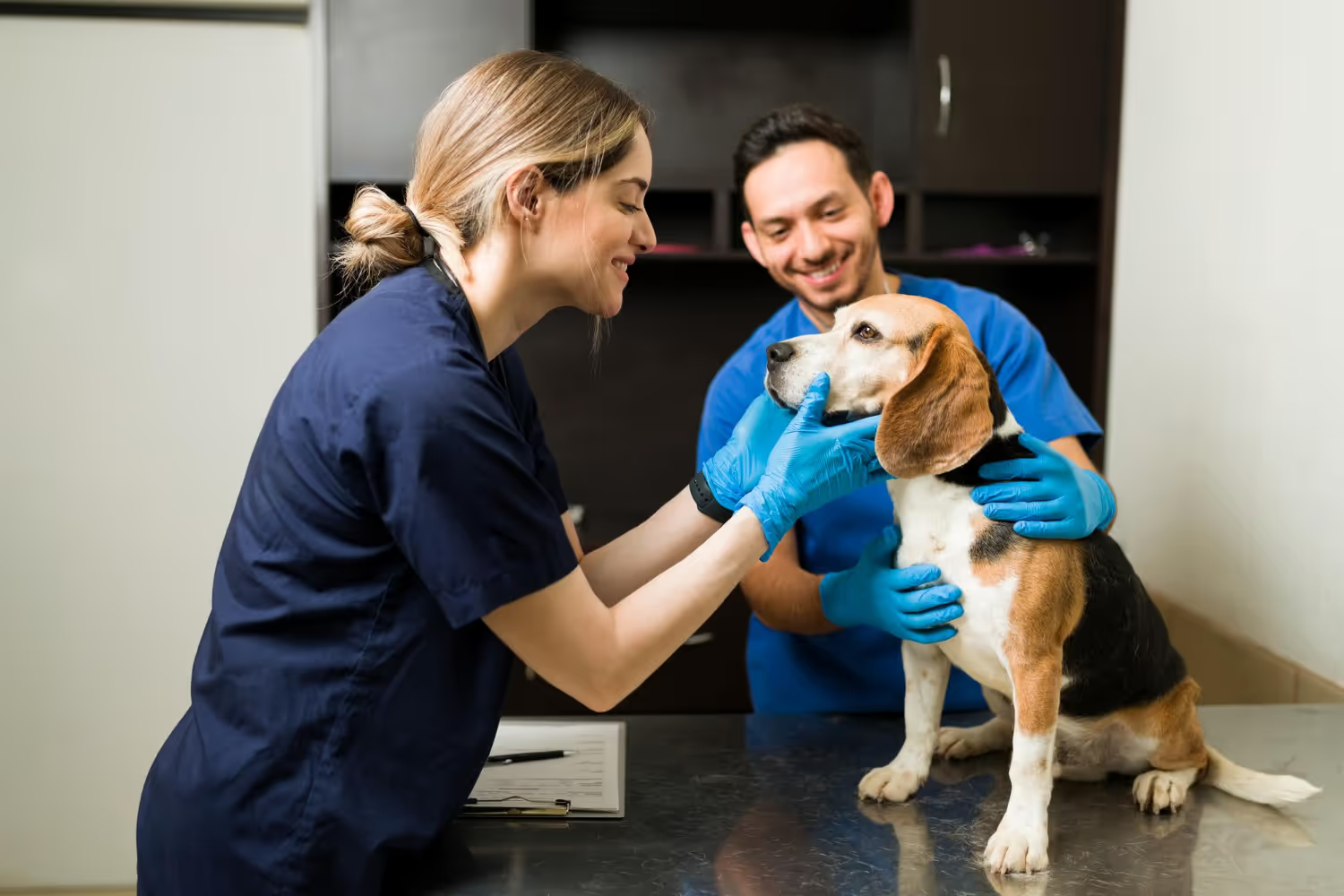

You may be starting to hear the term “Human Factors” more and more within the veterinary profession (which is great!), but what exactly is the field of Human Factors, and why do you – as a veterinary professional – need to know about it?
To start with… What do we mean by Human Factors?
The study of Human Factors is a well-established discipline across many professions from human medicine and to aviation, and more recently, veterinary medicine. It combines scientific knowledge about the human body, mind, and behaviour to better understand both our capabilities and our limitations – both of which, you will recognise, impact upon patient care.
Put simply, it can be defined as learning how being human can enhance, and not limit, our performance in veterinary practice.
How often have you nearly made the same mistake someone else did last week? Or snapped at a colleagues or client because you haven’t stopped for a break all day? Factors such as stress and fatigue, barriers to communication, and poor workplace culture are all examples of Human Factors that can prevent the knowledge, skills and good intentions of our veterinary teams from achieving their intended outcomes and being at their best.
Why is the science of Human Factors relevant to me as a veterinary professional?
As veterinary professionals, we possess a huge amount of skill, knowledge, and experience – both clinical and non-clinical. These are essential to our roles.
However, simply possessing these skills alone does not automatically lead to safe care for our patients - our performance as members of the vet team is impacted by so much more. When we think about it, it seems so obvious! Of course we perform better when we are rested, hydrated, nourished, and working within a positive workplace culture where we feel safe to talk about our great results… and our not so great ones. Yet how many of us truly prioritise these factors when thinking about how we or our team could perform better and provide the highest level of care for our patients, as well as reduce the risk of errors? Do we truly recognise just how much these “Human Factors” impact on our patient outcomes on a daily basis?
Improving clinical performance and patient safety all starts with knowledge and awareness. Once we understand what mistakes are being made, and what factors are leaving people vulnerable to making them, we can take steps to reduce the chances of, and mitigate the effects of, mistakes in practice: looking at not just what happened, or who was involved, but why and how did it come to happen.
Creating and supporting this “learning culture” and helping our team members to develop and nurture a growth mindset are critical to creating practices and organisations where people feel psychologically safe and can perform at their best.
How would Human Factors training enhance my role in the veterinary team?
Patient safety and reducing the risk and impact of errors in practice are a big part of Human Factors, but when implemented well, it can be a lot more. When we focus on ‘as many things as possible going right’ compared with ‘as few things as possible going wrong’, we increase our potential to learn and develop both our teams and our performance. In addition, how people feel is critical to how they function.
Learning how we have evolved to respond to stress on a physiological level will help you switch on your rational brain when faced with a stressful situation, and not your sympathetic response.
Recognising just how much factors such as tiredness, hunger, thirst and worry impact our clinical decision making – and how coming up with strategies to reduce them will enhance your performance and wellbeing.
Understanding how to make positive systems changes in your organisation, and shift from a blame culture to a “just culture” will enable you and your team to perform at your best and deliver the highest level of patient care possible.
A workplace in which learning from our good days and our bad days is openly encouraged at all levels of the team is far more likely to achieve their goals and, ultimately, will be one that people want to join and stay in.
Where can I find out more?
VetLed deliver training courses, coaching initiatives and positive change programmes to foster high performance in veterinary teams. Our experience across the fields of healthcare, aviation, Human Factors training, elite sport and psychology have led to our holistic approach to performance.
We are excited to be bringing the first ever Veterinary Human Factors Conference on Friday 26th February 2021. Whether you have previous experience of Human Factors, or if this topic is completely new, The Veterinary Human Factors Conference will benefit the ability of your team to deliver safer patient care.
To find out more or register your interest, email us on info@vetled.co.uk – we love hearing from you.

(This guest blog was first published on our previous website)
If you are a veterinary practice owner, you are likely to be familiar with the current recruitment issues within the profession. Does your heart sink when a team member gives their notice? Is there anything you can do to make it less of a headache?
Attract Recruit Retain are not claiming we can solve the problem. However, our aim is to help veterinary practices develop the best possible short, medium and long-term recruitment plans, maximising their chance of attracting, recruiting and retaining team members who will add value to their business.
We suggest there are several questions which need to be addressed in the journey to strategic recruitment planning and success:
1. What are we trying to achieve with your veterinary practice?
A meaty question, and not just about business strategy. This is the long-term, what kind of veterinary practice do we wish to be? Why? What does success look like for us?
This is the most important question of all, yet often bypassed in preference of the short-term view. However, the value of the leadership team taking the time to understand their collective thoughts should not be underestimated.
2. What are our current resources and capabilities?
If you know what you want to achieve, do you have the resources and capabilities to achieve it? How do you know? There is little point in trying to be the surgical referral centre for the area if you don’t have theatre equipment or a capable surgeon.
3. How are we developing our current team?
The processes of understanding, engaging with and developing progression plans for your team members are two-way, where business objectives and individual objectives play a part. Team members often stay in a role because they feel they have control over their career development, constantly learning and contributing to a worthwhile purpose.
4. What is our reputation as a veterinary practice?
Gone are the days of “behind closed doors.” Never have veterinary practices been so visible. Reputation spreads far and wide. Therefore, this is a valuable tool to develop as you think proactively about recruitment.
5. What are our likely long-term people requirements?
In a busy work environment, it is easy to fall into the trap of inadequate planning. However, the industry environment and wider influences are not going to wait for you. Take time to consider the likely changes and how that will impact your team.
6. How do we begin to contact the right people?
Recruitment should start long before you have an imminent vacancy. If you have answered the first 5 questions, you can start to connect with the type of people you may wish to employ in the future. How you do this will be unique to your business but should be strategic.
7. How do I conduct a job analysis?
The time has come where you have a vacancy. Without a job analysis, the chances of you employing a team member who adds value to the practice and stays with you are hugely reduced.
8. Have we got a planned reactive recruitment campaign?
From the budget, to advertising, to producing the copy and more, do you know how to conduct a recruitment campaign. Whose responsibility is it?
9. How do I assess candidates for the position fairly and effectively?
Don’t be tempted to jump for the first or only applicant without clearly assessing whether they meet your competency and person specification criteria. How you conduct your assessment is personal choice but must be fair. Remember, while appropriate interviewing is still very useful, there are several other assessment options.
10. When and how do I decide?
You may think this is obvious but be careful. Bias and preconception are never far away from decisions. It is important to take time, be aware, ask others and keep it fair and legal. More than gut instinct needs to be considered.
11. What do we need to do to ensure our new team member feels supported and quickly becomes valuable to the business?
If you have conducted steps 1-10, the hope is that you have employed a person who is going to be happy in their work with you and quickly add value. But don’t take it for granted. All too often, the busyness of the practice takes over. Processes should be in place for ongoing support, discussion, progression and development. Again, this will be unique to your practice, but roles must be defined and remain accountable.
None of these questions have quick or easy answers. They will take time, effort and often guidance to help practices consider, understand and instigate positive steps for change. The recruitment crisis isn’t going to disappear overnight but we in practice can be better prepared. Attract, Recruit, Retain are here to help.

(This blog was originally published on our previous website)
Two pretty much identical jobs: same area of the country, similar role responsibilities, similar remuneration, similar business size and structures. Yet, one ad receives four quality applicants and the other receives none. Why?
Both veterinary practices have clear plans for the future and are investing in their current teams and business to ensure provision of a quality service for clients. Both practices could be a great place to work. However, one of these practices has a reputation as a good employer, the other has none. We don’t mean a bad reputation, simply no reputation- people haven’t heard of them.
This was something I would encounter on a weekly basis when working in the defence recruitment sector and it is a very real problem within the veterinary profession. When we discuss marketing within the business, the tendency is to focus our efforts on the client and that is important. However, the scarce resource within the vet profession is not clients, it is employees.
The power now lies with the employee and that means, if they must choose between applying for a job with a practice which they have heard of and a practice which they have not come across, they are likely to apply for what seems the lower risk option. If you advertise a vacancy before candidates are aware of you, you are going to struggle to recruit.
Yet in a time poor, resource poor profession, can you afford to invest in building an employer reputation? How do you keep it efficient and effective?
This is where we will begin in Part 1 of our online, interactive course: Finding the Right Person for You. We will help delegates to answer questions such as:
- Why do we exist?
- Who are we targeting?
- Why would they want to work for us?
- How are we going to communicate with them?
Once we have established the base knowledge needed to build a positive reputation, we will learn to plan and run a successful recruitment campaign. Part 2 of the course will then complete the recruitment cycle, covering candidate assessment and making the right decision for your business.
Some veterinary practices don’t struggle to recruit. Why? Because they have learnt to communicate what they are practising day-to-day to those who they would like to hear it. Join us to do the same.

(This blog post was first published on our previous website)
Dan Tipney, our Head of Evidence and Insights, reviews 'Outliers' by Malcolm Gladwell and gets to grips with what makes someone highly successful.
The author of Outliers, Malcolm Gladwell, has a diverse background both in terms of geographic location and experiences. He was born in England, grew up in Canada, and worked in the USA. He studied history followed by a career in journalism, initially covering business and science. Such an array of environments, locations and areas of expertise likely led him to a great variety of experiences, cultures and opportunities. His acute awareness of this and his subsequent success is what I believe led him to writing this book.
He brilliantly dispels the myth that highly successful people are simply born with huge talent and therefore achieve great things. Similarly, he goes against the grain of many popular ‘miracle’ books which suggest that anyone can achieve anything…as result of reading this book. To this end he comprehensively describes why simple hard work by itself is not enough.
Having read Outliers the message I have taken away is about what separates outstanding achievers from everybody else. It is not simply their huge talent, or willingness to work extremely hard, but opportunity. This is not to say that the likes of Bill Gates and The Beatles were lucky. Far from it; they really were talented and really did work hard. But arguably their biggest talent was not as a computer genius or as musicians but it was their awareness of opportunity and their ability and willingness to capitalise on it.
This aspect of Outliers I think is highly valuable to many of us as it gives a realistic and a balanced way of understanding how to maximise your chances of achievement. Rather than suggesting you should forget what you know, follow this recipe, expect success and inevitably end up disappointed the message here is far more helpful; Know your strengths, be prepared to work really hard and when you see an opportunity then make sure should grab it by the horns. With this approach there can always be a sense of optimism, as like in many of the examples in Outliers – what often seems like your biggest knock down can turn out to be your greatest chance.
The other aspect of Outliers that rings particularly true to me is about culture and the role that it plays in so many outcomes. Whether it is the heart health of an area such as Roseto, the safety record of an airline or the success of different nationalities at the Math Olympics, Gladwell describes the significant impact of culture and environment on our behaviour and the resulting consequences.
I think reading the book will help people become more aware of the culture which they are from and in which they now live or work. This helps with self awareness and awareness of others with the resulting possibility that you can better cooperate, empathise, influence and make change. Korean Airlines is a great example because without this awareness, trying to make changes would have only caused conflict, increased stress and decreased performance – whereas the actual result was quite remarkable and well worth reading about.
Outliers expanded my thinking in terms of our environment and its implications in terms of what we hope to achieve. Culture could refer to the country or town you grow up in but it could also be on a smaller scale such as ‘way things are done’ in your house or place of work and this could have huge implications on behaviour and the resulting outcomes.
Ultimately Outliers tells you all about just that – people who lie out with the ordinary, as a result of great success. By understanding the truth behind their success and the bigger picture in terms of what contributed to their behaviour that made them so successful, I believe we all have the opportunity to make the most of our talent and our potential.

(This blog was first published on our previous website)
In this guest blog, Stacey Blease provides an insightful ad thoughtful view of a recent event - 'Failure Friday'.
Perhaps the title of the ‘Failure Friday’ event on first glance could be perceived as negative. However, having experienced many positives from ‘failures’ I was curious about the University of Salford’s event within their Festival of Research. The aim of the event was to challenge the misconception that failure should be avoided and something to be ashamed of, instead highlighting how failure can bring insight and inspire action which are building blocks to success.
From my experience within the veterinary profession, it could benefit from being more open about ‘failure’ to help our patients and equally as importantly, ourselves. This is why I was curious to learn more from other industries on their approach to ‘failure’. The first part of this summary focuses on the challenging the perception of failure and challenging expectations.
The two speakers representing the science showcase, Sara Namvar and Marija Krstic-Demonacos both spoke about the pressure of the ‘traditional route’ in science starting with a bachelor degree, masters, PhD, post-doc and fellowship. Deviation from this conventional pathway can be perceived as a ‘failure’. The parallel in the veterinary profession which sprung to mind at this point was the perception that not being a vet or vet nurse in practice is deemed a ‘failure’. Social norms have a lot to answer for. Being content with our own choices and responding to changes in your priorities at different times in your life is not a failure if it works for you. There are lots of vets and nurses working within teaching, research, government and pharmaceutical companies who are all contributing to the profession. There are vets and nurses who have chosen to leave the profession.
Choosing a different path is not a failing in my book.
Ursula Hurley and Davina Whitnall from the University of Salford Doctoral School spoke about embedding a culture of ‘failing better’ starting at the induction week. They shared their ‘fail better’ manifesto which included acknowledging that failure is present within academia, address fear of failing, supporting life-long learning, understanding that failing is a learning opportunity. I must say, I was impressed. I remember during my first week of my PhD someone asking me why on earth would a qualified vet want to do a PhD. Lots of reasons!
We were introduced to the ‘Wall of Failure’ and were invited by Ursula and Davina to write down a failure we had experienced on a post-it note and stick it on the wall. We were asked to partner up and tell the story about our failure with our partner making notes on the narrative. Next we were provided with a piece of paper titled, ‘Silence your inner critic by consciously adopting positive vocabulary’. We were asked to visit the ‘Failure Reframed’ wall armed with a new post-it note which described a positive productive outcome of the ‘failure’. A simple but very effective exercise.
Challenging the way we perceive failure is essential to be able to learn from the experience. By reframing it, it can be perceived as less of a failure and more as a positive step forward which is the focus of the second part of the summary on accepting failure as a normal aspect of progression.
Normalising failure
The second part of the summary of the University of Salford’s ‘Failure Friday’ event focuses on normalising and accommodating failure as a component of any process. Professor Karl Dayson, Dean of Research at the University of Salford stated that it is important to have the self-confidence to say that at some point along the way, failures will be encountered but they need to be accommodated in the plan. The example he used to illustrate this point was the approach to car manufacturing in the USA and Japan in the 1970s. The American car manufacturers were focused on producing a large quantity of cars quickly compared to the Japanese companies who tested their cars at several different points within the production process. By continually testing the cars and determining failures throughout the process allowed for processes to be amended according to the feedback. Japanese car manufacturers where slower in producing cars when compared to their USA counterparts but in the long term, the Japanese cars had, and still have a reputation for being reliable cars. The process might be slower but the end result was worth it.
Musical composers Alan Williams and Dan Mattix work with the University of Salford’s School of Arts and Media described their working process in a similar way to Japanese car industry. They spoke about ‘failure’ in the arts being an integral step in developing successful compositions. This reminded me of a keynote presentation by Dr Gregory Wolfus’ from Tufts at Tech Community Clinic (Massachusetts, USA) at the VetEd Symposium who explained that at the end of each rotation the students are asked to share and reflect on any mistakes or things which could have been improved. Allocating time to reflect on the progress resonates in music composition, car manufacturing, self-development and could benefit lots of different teams within a wide range of industries.
Lecturer in TV and Radio Production, Lyndon Saunders introduced attendees to a module within a course he teaches on called, ‘Docs Without Rules’. Lyndon explained that he observed a trend of students playing it safe when it came to producing a documentary. With his colleague, they decided to revamp their approach to provide space and a platform to be creative by trying new approaches without fear and daring to be different.
Robert Richie who is Head of Organisational Development at the University of Salford shared ‘The Salford Behaviours’ that describe behaviour traits which are encouraged at the university.
Interestingly, ‘daring’ was listed as one of the behaviours so in the same way ‘Docs Without Rules’ was encouraging students to try different approaches, this same message is being echoed to the staff members. Robert stated that words are cheap and it is the behaviour and actions people take which are important. I completely agree! You can say you hold particular values but it is peoples’ behaviours and actions that speak louder than words.
The keynote speaker, Professor David Brettle provided a very honest account of his life when he was invited to speak on the topic of, “A Successful Failure”. The running theme of Professor Brettle’s presentation was his ‘mojo graph’. Mojo was used as a measure of success at different stages of his life both professional and personal. David used Cambridge Dictionary’s definition of mojo, “a quality that attracts people to you and makes you successful and full of energy”. David shared the highs and lows of his life to date represented by peaks and troughs on the graph. As a former President of the Institute of Physics and Engineering in Medicine, Head of Medical Physics and Engineering at Leeds Teaching Hospital Trust and Honorary Professor at the University of Salford it might be easy to assume that David has not experienced setbacks in his mojo. Learning from all of your experiences, both good and less-good, aids progression. David’s mojo peaked with the development of the Little Linac Project. This project was successful in its aim to provide every child in the UK receiving radiotherapy treatment for cancer with a free kit of play bricks to build a model linear accelerator (linac) to alleviate stress and anxiety. When concluding his presentation, a trendline was superimposed which revealed a positive linear trend of his mojo. Professor Brettle’s advice to the audience consisted of pursuing passions and if you are ahead of the time, keep pushing.
Attending Failure Friday was a wonderfully positive experience and I applaud the University of Salford, speakers and attendees for being incredibly honest about their experiences of failure. Turning a negative into a positive is not always easy but the more you do so, the easier it becomes.

(The fourth in a series of workplace culture blogs written by Stacey Blease on behalf of VetLed, first published on our previous website)
Mindset Matters.
Is it a threat or a challenge?
I see new opportunities as experiences to learn and further develop myself. I like a challenge! About a year ago when I learnt that this is an aspect of having a ‘growth mindset’ as opposed to a ‘fixed mindset’ of believing that having an aptitude for something or not, is static. These terms were coined by Carol Dweck, a researcher in the field of motivation. Thinking back to my school years, I was more fearful of putting myself in situations unless I was pretty confident that the outcome would be positive. The fear stemmed from the possibility of failure or making a complete fool of myself so I was more likely to stay within my comfort zone. It felt like a threatening experience to try something new because generally, society deems that success is good and failure should be avoided at all costs. Talking about failure was (is? Depends who you are talking to) taboo. If we don’t try new things outside our comfort zone, how will we ever know what we are capable of? Trial and error are a part of the learning process.
Framing
A team of researchers from the University of Exeter carried out a study assessing the effect on golf putting performance when the activity was framed in a challenging versus a threatening manner. The study found that the participants who were given information about the activity in a way that made it sound like a challenge and the organisers had believed that they could do it, performed better than those who received information which framed it in a negative way stating that most people don’t perform the task very well (Moore et al. 2012). I can remember on several occasions vets telling me that it’s not too late to change my UCAS application form because being a vet isn’t all it’s cracked up to be. Does this kind of comment frame being a vet in a threatening way?
Reframing
Synonyms of failure include words such as defeat, loss, inferior, unhappiness so it is perhaps unsurprising that the stigma associated with failing may be hard to shake off. Success is the antonym of failure, but is it really that black and white?
When I was working as an Editor-In-Chief for a journal and rejecting an article for publication, I made it clear that if the article was within the guidelines and scope of the journal, the article was not ready for publication yet. I felt very much like I was channelling my inner Carol Dweck. I was concerned that the authors would see the word rejection and stop reading the feedback I’d provided. Carol Dweck talks about the ‘power of yet’ which helps to give people the belief that with more time and effort, the goal can be achieved (Carol Dweck TED Talk).
Having been on the receiving end of the crushing unconstructive criticism from the infamous reviewer two, I strived to help authors by providing feedback that would help to improve their article for publication. My PhD supervisors helped me to normalise this failure of rejection and showed me how reviewer one provided some interesting points to help me further develop the manuscript. Reframing ‘failure’ can sometimes be tricky in isolation. I encouraged authors to contact me for clarification if any aspect of my feedback required it, and I was fortunate to be able to offer mentoring for authors from members of the supportive editorial board.
Just keep persevering?
People with a growth mindset won’t keep persevering on worthless challenges. Matthew Syed who is well known in the performance and cultural change arena wrote that “people in a growth mindset can pivot onto new challenges, but they are more likely to do so for the right reasons.” (Matthew Syed Consulting). My personal method is to observe and understand approaches, processes and situations to see what I can do to affect change. If, after persevering, things outside my control remain the same, I pirouette (rather than pivot but same principle and I like dancing!) onto the next adventure.
Maintaining a growth mindset
I have had my fair share of wobbles along the way! By framing opportunities as experiences to learn, therefore as a challenge, you have a more positive mindset and are more likely to succeed. Any ‘failures’ can be reframed which can be tricky but easier with a supportive friend/family member/colleague/mentor.
.png)
(The third in a series of workplace culture blogs written by Stacey Blease on behalf of VetLed, first published on our previous website)
Learning From Excellence
If it seemingly ‘ain’t broke’, should we bother trying to make it better?
The previous articles looked at attributes of continuous learning and making improvements when things go wrong or when an error is narrowly avoided. Errors happen less frequently than aspects of practice which are performed correctly. Should we wait for a mistake or near miss before trying to improve how we work? If it ain’t broke, don’t fix it, right? I disagree. If you are like me and you ask someone why they do something, and the response is, “because that’s the way we’ve always done it” alarm bells will start ringing. This article looks at the benefit of learning from the gap between what best practice suggests and what we actually do, and the advantages of learning from excellence.
Suzette Woodward who is the former Director of the ‘Sign up to Safety’ campaign suggested that in order to obtain a complete picture of patient safety we should be looking at both ends of the spectrum of successes and failures. ‘Safety I’ is more of a reactive approach of how processes can change as a result of a specific error compared to ‘Safety II’ which is proactively assessing current methods or techniques and determining the successful aspects of them (NHS Patient Safety Strategy video). I really like the Sign up to Safety tagline which is “listen, learn, act”. I am completely onboard with this!
Adopting assumptions
You might be thinking what’s the point of looking at processes which have not resulted in some kind of failure. In her video Suzette discusses the difference between work as intended versus work which is actually done. Assumptions can be dangerous. There may well be standard operating procedures (SOPs) outlining best practice but what is actually happening on a daily basis? If there is a gap between how we would like to do things in order to improve patient safety, health and welfare, and what is actually being done, the gap could lead to errors and near misses. In order to investigate the gap, it would be really useful to have a just culture, otherwise when asking or observing your colleagues to ascertain how certain tasks are being carried out on a daily basis you might get a model answer or performance if they feel that they are being scrutinised. Framing the exercise in such a way that we would like to close and hopefully eliminate the gap, we need to understand why particular steps are missed in the SOP so that we can overcome the barriers together.
Appreciating excellence
Focusing on errors or gaps in what we say we are going to do and what is actually done, both of these come from places of inadequacy of some kind. Can we learn from what we do really well? Yes! This is another aspect of safety II. Understanding what factors are needed for success helps to provide a framework which can be applied to other situations.
I came across a ‘Learning from Excellence’ pilot study performed by an obstetrician and researcher in a hospital in Dublin. For one month, forms were distributed requesting examples of individuals and team excellence from all of the hospital departments. Using the feedback from the 18 teams and 27 individuals who were described as demonstrating excellence, four themes were identified: “excellence in daily work”, “identifying problems, proactively solving them”, “emergency care” and “educational initiatives” (Higgins, 2017). In the article Dr Higgins expresses the importance of the fourth theme of “educational initiatives” underpinning the other three themes and is essential for clinical care. This kind of initiative which celebrates successes can boost morale and appreciation, aid collaborative learning and further enhance patient safety.
The excellence, the errors and the gap
There are different sources of information to improve the safety of our patients. We can champion examples of excellence, learn from mistakes and examine the gap between the two. With this three-pronged approach to obtain feedback and subsequently apply it in practice will help to further improve patient safety. The presence of a just culture cannot be underestimated to support the reporting of accurate information when near misses and mistakes occur. In addition, adopting a growth mindset will assist in responding objectively to learn from the incident and if you are the person who shares the feedback with the team, not to create a threatening situation resting on the shoulders of specific individuals. Instead it is important to frame it as a collaborative challenge for all team members and the practice to support the commitment to continuously assess how to improve patient safety.

(The second in a series of workplace culture blogs written by Stacey Blease on behalf of VetLed and first published on our previous website)
A Just Culture?
The vet and the three practices
In the previous article I mentioned how I had been in a car accident but I didn’t tell you that I skidded on black ice, the car slid into a ditch and rolled onto its roof. Did the environment play a role in my accident?
Mistakes can happen for many reasons. Should the blame rest on the shoulders of one individual? Deliberately reckless incidents are thankfully rare. What about genuine mistakes? Fortunately, many industries are moving away from a blame culture to a just culture which examines incidents holistically by assessing the working environment and systems in place rather than simply putting the people involved under the microscope.
Imagine that you were invited (unlike Goldilocks) to three different practices for interviews because you were considering a new job. In the first practice there were several heated conversations taking place where the flow of patients between the prep area and theatres was clunky due to miscommunication. You notice that they were using techniques considered suboptimal according to data published in several evidence-based articles. During your visit to the second practice, there was a frosty reception, some anxious smiles and lots of people rushing around. The Clinical Director was dictating the order of the day and looking over peoples’ shoulders throughout your visit to the practice. The atmosphere in the third practice had a more genuinely supportive feel to it which started with one of the partners stating that there’s no such thing as a stupid question. There were several vets and nurses helping to decide the plan for the day based on their knowledge of the patients. The team was working in an environment where systems were in place with all staff members contributing and communicating effectively to ensure the day could run as smoothly as possible. Based on your initial impression, which practice would be your first choice?
Just culture recipe
Teams with a just culture will experience setbacks and errors but it is how these are dealt with that is crucial. I have come across several different descriptions of what a just culture is within different industries. Here is my interpretation of the themes commonly discussed when organisations are aiming to develop a just culture.
- Lifelong learning
A commitment from both the individuals and the organisation to strive for improvements and an openness to learn is key. There is a willingness to modify existing or adopt new practice policies in response to new information.
- A team approach
The organisational hierarchy is minimised and team members with the relevant expertise have chairs pulled out for them at the table. Support is provided at all levels because we can all make mistakes.
- Responsibility
Individuals are accountable for their decisions and deliberately reckless behaviour will be sanctioned but events arising from inadvertent human error are used as learning opportunities for all staff and the organisation.
- Consistent approach to dealing with mistakes
Having a fair and consistent approach to dealing with situations when something goes wrong and ensuring that all team members are aware of the process which involves looking at the situation holistically.
- Psychological safety
Working in an environment where everyone is invited, encouraged and feels confident to share their thoughts and experiences without the fear of judgement (see previous blog).
The purpose of achieving a just culture is not to provide a fluffy and light cake which looks pretty but is not worth the calories. The aim is to provide a working environment which has a solid base to acknowledge that mistakes will happen and the assurance that genuine mistakes will be used as learning opportunities for the individual, their colleagues and the practice in order to change the way we work and ultimately improve patient safety. This solid base would also include being informed on standardised procedures for reporting incidents and near misses which would reduce ambiguity and therefore, anxiety. Implementing a just culture needs to be deep-rooted in the way all team members approach all aspects within the workplace.
The police statement for my car accident was very straight forward and was a part of the routine procedure. I wish I’d known that earlier! The just culture recipe isn’t one you can whip up and shove in the oven, it requires teamwork, education, a framework and the desire to improve patient safety and your colleagues’ wellbeing.
After graduating from the University of Liverpool Vet School with an intercalated Master’s degree from the Royal (Dick) School of Veterinary Studies, Stacey worked in general practice. She completed her PhD at Harper Adams University on dairy herd health planning. Stacey has worked for an online CPD provider, The Webinar Vet and the British Veterinary Nursing Association (BVNA) as the Head of Learning & Development. Currently, Stacey is a trustee for the Animal Welfare Foundation (AWF). Stacey's experience is diverse and her passions include research, education, organisational culture and innovation.

(The first in a series of workplace culture blogs written by Stacey Blease on behalf of VetLed , first published on our previous website)
"Is it possible to fail safely?"
Stabilising confidence
The University of Salford’s Failure Friday event within their Festival of Research has further sparked my interest in this area. I started to think about how as a child, there were often mechanisms in place to allow us to fail within a safe environment. A classic example is learning to ride a bike. Initially stabilisers are used which are at ground level.
As ability and confidence grow, the stabilisers can be raised gradually until they are no longer needed. I am not sure how long my parents kept my stabilisers for but I am pretty sure they held onto them for a while just in case of multiple wobbles and falls to help rebuild my confidence if needed. Sticking with the transport theme, when having driving lessons with an instructor, the car often has dual controls so that learners have the experience of driving a car but the instructor can intervene to prevent a near miss becoming an accident. Both of these scenarios are appealing because people know they can try to learn something new with support until they are confident.
Have I fallen off my bike as an adult? Yes. Have I been in a car accident? Yes. Even though I have many years of experience with both forms of transport, accidents still happen.
Cultivating confidence
Both of the examples above describe learning a new skill with physical support of stabilisers or dual car controls but as a veterinary graduate, you are not issued with stabilisers or someone to sit next to you with dual controls and the ability to override your actions should things start to go awry. Let’s face it, there is a steep learning curve after graduation and every day is a school day. Although physical safety aids might not be present, is there more that could be done psychologically to provide support in practice?
Making mistakes is a part of the learning process but depending on how near misses and mistakes are dealt with, they can have a detrimental effect on confidence. If individuals are blamed and vilified for accidents, mistakes and even near misses, the chances of reporting such incidents are reduced. However, if employees are working in an environment which invites people to share ‘failures’, the individual, his/her colleagues and the practice can benefit by learning from the incident. Regularly discussing near misses and incidents can help to normalise this topic of conversation and minimise the worry individuals may have when it comes to speaking up.
“Psychological safety describes perceptions of the consequences of taking interpersonal risks in a particular context such as a workplace” (Edmondson, 1999).
To be honest when I first read this, I wasn’t sure what the definition of ‘interpersonal risks’ was but further in the article it stated, “a sense of confidence that the team will not embarrass, reject, or punish someone for speaking up”. I think this would apply to a wide range of scenarios from mispronouncing a word (very easy with some of the drug names within veterinary medicine!), sharing new ideas, asking for help and when talking about mistakes. Working within a team where a culture of high psychological safety is present allows people to be human. We don’t get it right all of the time but having psychological safety stabilisers will help to encourage people to express concerns and share ideas to further improve patient safety in practice.
Confidence is crucial
Confidence allows you to be curious and try new things, provides a platform to obtain feedback and share ideas, enables you to support your colleagues and demonstrate leadership qualities.
Confidence comes when you work in an environment where you can share your thoughts, experiences and mistakes without fear of judgement. This will not make veterinary practices and hospitals immune to errors, however it will help individuals learn and share, ultimately improving patient outcomes.

(This blog post was first published on our previous website in 2019)
On 7th May 2019, I was proud to be involved in the very first comparative medicine conference of its kind; Human factors in patient safety: Comparative lessons from human and animal healthcare, organised by the Royal Society of Medicine in association with VetLed and MedLed. There was a great range of speakers discussing a broad array of topics which touched on non-technical skills, safety reporting, just culture, wellbeing as well as more in-depth reviews of how teams can reliably deliver their clinical skills.
The day started with John Pickles, Chair of the Clinical Human Factors Group who discussed the current climate of Human Factors in healthcare and whether or not the topic has reached a ‘tipping point’ whereby the principles have become so ingrained as to be self-sustaining. Liz Mossop followed John’s talk to offer a similar overview of the landscape of Human Factors in the Veterinary profession. Whilst it is evident that both professions are on an ever-evolving journey, it is a journey that has started somewhat more recently within animal healthcare. In many NHS trusts a great deal has changed over the past 15 years and there are signs that a similar shift is occurring within the Veterinary field, with Human Factors a well-established and ever-growing area of research and development.
Catherine Oxtoby spoke next about her fascinating research into human error, learning and reporting within Veterinary teams. Catherine discussed VetSafe, a profession-wide safety reporting system which she has developed, and the crucial aspect of gaining ‘buy-in’ across all levels of the team. She also covered the emotional considerations that are associated with a blame culture (or a perception there-of) and how anxiety associated with errors and safety reporting should never be underestimated with regards to their impact on learning and wellbeing.
Suzette Woodward’s response emphasised the importance of learning from adverse events and error and also elaborated to give a broader view to stimulate thought on how we can think differently about patient safety. She discussed incident reporting as a vital ingredient but not safety in itself. Addressing only events that go ‘wrong’ (this approach is known as ‘safety I’) can detract from the 100s, or likely 1000s of times that process has taken place when it hasn’t gone wrong. This ‘normal’ (sometimes exceptional) day-to-day performance is important to understand (known as ‘safety II’) so that we can help create systems and develop skills which enable teams to reliably deliver safe and compassionate care.
Professor Bryn Baxendale discussed how we can build Human Factors awareness and capability in daily practice by taking a ‘systems’ view and by appropriately applying solutions based on an understanding of the complexity of various processes. A few models of complexity were touched upon, one such model categorises tasks as simple, complicated and complex as originally described by Charles Vincent and René Amalberti.
This is relevant to both animal and human healthcare because they both involve processes which span the full range. From a Human Factors perspective, understanding such complexity will have significant implications on how teams and organisations can approach tasks in a way that applies an appropriate balance between compliance with procedures and supporting professional expertise and freedom.
Huw Stacey, Clinical Director at Vets4Pets, shared with us his experience of introducing Human Factors in Veterinary Practice. This provided an interesting contrast in terms of the management structure of his organisation versus something like the National Health Service. The level of autonomy afforded to each of the many hundred practices in the group is a significant part of his challenge and as such, Huw described the importance of focusing on buy-in across all levels of their teams. In the long term, what is currently a challenge could indeed turn out to be a great strength, if true buy-in is adopted rather than enforced compliance.
The final stream of the day was focussed on wellbeing. Dr Michael Farquhar, Consultant in Sleep Medicine at Guy's and St Thomas' NHS Foundation Trust delivered a highly emotive presentation on why we need to talk about fatigue. He openly shared his personal reasons for the HALT campaign that he has led at Guy’s and St Thomas’. HALT is an acronym for Hunger/Thirst, Anger/anxiety, Late/lonely and Tired - areas that are known to leave us vulnerable and less able to perform at our best. Dr Farquhar’s campaign was focussed around rest and sleep but his message was clear and is one that applies to all areas of wellbeing – that unless critically ill patients require your immediate attention, our patients are always better served by clinicians who have taken the time to first care for themselves. Much of his work in this area seeks primarily to address what he refers to as the Superhero mentality of many healthcare workers. Whilst he recognised that this approach comes with the best of intentions, in fact it can have negative impacts on their own health and wellbeing as well as their ability to offer their best for their patients and colleagues.
The talk also served as an opportunity to learn more about sleep and human performance. We all know that alcohol can negatively impact our ability to focus and make decisions and as such would ensure we are not under the influence when treating patients. However, being awake for 16 hours has the same impact on our cognitive performance as being at the legal drink-driving limit. As Dr Farquhar pointed out, many of us would not address fatigue with the same diligence.
I had the absolute privilege of speaking next, presenting the final talk of the day.
I chose to tell the story behind VetLed's HALT campaign as it was something with which we were fortunate enough to have the support and collaboration of Dr Farquhar, following the campaign at Guy’s and St Thomas’.
This provided me with an opportunity to not only summarise the key points from what we did and why this was so important to the Veterinary profession but also an opportunity to summarise an important principle from the whole day - that of collaboration and what I described as ‘translating not transplanting’.
There is so much that can be learnt from one profession to another and the development across the fields of Human Factors and Patient safety are no exception. Our Veterinary HALT campaign was inspired and based upon Dr Farquhar’s campaign at Guy’s and St Thomas’.However there was a great deal of work required so that is was appropriate for Veterinary teams.
I also had the opportunity to summarise another key point that came up several other times over the day - the crucial link between wellbeing and Patient Safety. I have so often heard these topics discussed in separate breaths, yet so many times over the day, the message has been reinforced that wellbeing is(and must be treated as) an integral element to patient safety. If we work in a system that does not support the basic physiological and emotion needs of the care-givers, their ability to look after their patients will be compromised.
There was a great energy and sense of enthusiasm throughout the whole day. Elizabeth Haxby’s introduction as President of Patient Safety Section at the Royal Society of Medicine created a sense of collaborative spirit as she described her Grandfathers pertinent role in the Veterinary profession. The day was closed with similarly warm concluding remarks by Gwen Covey-Crump (President of Comparative Medicine Network at the Royal Society of Medicine) which left everyone with a hunger for further discussions as both professions continue their respective journeys in Human Factors and patient safety.

(This blog post was first published on our previous website)
Dan Tipney, our Head of Evidence and Insights, gives the low-down on quality improvement following a day at the RCVS Knowledge Skills Day.
Back in November 2017, some of our VetLed team attended the RCVS Knowledge Skills Day. Here, I give my thoughts, reflections and personal insights from the day.
The RCVS Knowledge Skills Day focussed on Quality Improvement, or QI. As the VetLed areas of focus (culture, wellbeing, human factors and performance) are fundamentally aligned with QI, we were looking forward to connecting with industry professionals who share our goal of improving patient safety.
Needless to say, the term ‘Quality Improvement’ and what it means was discussed in some detail. The first talk of the day came from Dr Bradley Viner who explained the significance of semantics, his belief that QI sounds more inspiring than clinical governance, and the necessary focus on ‘improvement’. The message was clear that the process must be evidence-based but that the data is all but irrelevant if it doesn’t result in positive change. The second speaker of the day, Dr William Taylor, clarified the difference between Quality Control and Quality Improvement and commented that while there will always be a need for some control, too much can stifle improvement. I think this is a great perspective because it emphasises a growth over a fixed mindset.
Encouragingly, workplace culture was also discussed. Culture in this sense relates to the shared attitudes and go-to behaviours of all those involved in the practices, departments or groups in which improvement is sought. We believe that workplace culture affects how people think, act and feel more than anything else. A consistent example used was that of reporting error – if a blame culture (or a culture where it is the norm for blame to be apportioned to an individual) exists, the likelihood of team members sharing incidents/near misses is almost zero and the QI process stalls. What I would have been interested to hear more about was ‘feeling’. The word feeling was seldom used, but I feel that when it comes to inspiring a group of people to be an integral part of this kind of process, then how they feel matters more than anything.
Teamwork was widely discussed, with the importance of involving the entire team (vets, vet nurses, practice manager, reception) in the QI process being recognised. Encouragingly, this was often linked to empowerment (another key criteria for positive culture) and flattening hierarchy. From a human factors perspective this is crucial. If there is one thing that we have identified from human factors training in aviation and healthcare, it is that of helping to ensure that everyone’s voice is heard when it needs to be, regardless of seniority.
Unsurprisingly leadership was mentioned a few times! However, there wasn’t as much focus on leadership as I expected there to be, although it was indirectly referred to in other ways. For example, inspiring all members of a team to speak up, voice concerns and play their part in continual improvement (or during clinical situations) is a vital aspect of leadership, which can be demonstrated at all levels.
When discussing error, it was great to see that the emphasis was on normalising human error. This is a big challenge when dealing with high achieving professionals and was a huge step when Crew Resource Management training was introduced in aviation in the 90s. The vital take-away is that one of the first steps towards achieving a just culture (a culture which does not apportion blame or punish errors, but where reckless behaviour or wilful sabotage are not tolerated) is reducing the stigma surrounding mistakes, although arguably one of the hardest steps too.
Data was also discussed in detail and for good reason; it’s not possible to improve anything until you know what is going on! Compared to professions such as healthcare and aviation, the veterinary world is in its infancy when it comes to data. The focus on gathering data in practice was mostly based around clinical audit and significant event audit. I agree that collecting data is absolutely essential to seek positive change. I question, however, why there wasn’t more discussion on developing open reporting systems? If veterinary professionals could report positive events, near miss events and incidents, in a just culture without fear, where such reporting was encouraged daily, then I believe it would provide a great deal of insight. This method of data collection wouldn’t then rely solely on lengthy audits, and trends would be continually identified without an environment in which people know they are being ‘audited’. I wholeheartedly agree in audit processes, but I think open reporting would well compliment current and future audit systems.
Celebrate success! We enjoyed this message from several speakers throughout the day and it’s easy when discussing error and mistakes to become overly focussed on the negatives. I interpreted ‘celebrating success’ in two ways; firstly, most of the time things are being done really well and it’s important to recognise this. I likened this to a sports coach, whose job is as much about helping the athlete to know and continue what they’re doing correctly as it is about pointing out weaknesses. Secondly, when positive change is made, we need to celebrate it so that we are motivated to keep up with the QI process, and also to share with the wider profession.
The day closed with a focus on patient safety, and specifically the use of checklists. I applauded the sentiment from Matt McMillan who delivered this talk, when he pointed out that checklists don’t take away professional freedom or autonomy, they actually enhance it by freeing up critical mental capacity to focus on more complicated tasks. One thing I would have liked to hear more about with regards to checklists is the training and associated culture that is required for checklist implementation to work reliably. Atul Gawande demonstrated that major surgery complications dropped by 36% and deaths plunged by 47% following his introduction of checklists in 8 hospitals around the world. However, replicating these results on a wider scale has proved challenging. Two of the crucial elements are effective education and getting the buy-in to ensure conscious attention on the process as opposed to automatically ticking boxes. As such I would have been really interested to hear more about the training processes involved when such checklists have been introduced at various practices, so that we can all learn about what works and what doesn’t.
QI, by its very nature is an ever-evolving and forever-developing concept, and I am sure that much more will be discussed, reported and written about in time. It was great to connect with people who share our vision and we look forward to being part of the ongoing QI conversations in the weeks, months and years to come.
Dan Tipney is Head of Evidence and Insights at VetLed. Dan’s role at VetLed primarily involves providing insights into human performance gained from his perspective across multiple fields; formally as a semi-professional athlete, sports coach, pilot instructor, cabin crew member and currently as a commercial pilot and human factors trainer.



